FIBER ACROSS AMERICA
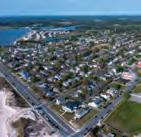







SUCCESSES AND CHALLENGES FOR SERVICE PROVIDERS LARGE AND SMALL

Accelerating Fiber Success
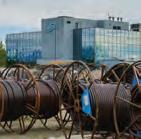
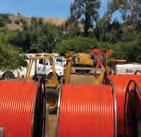

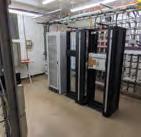










AT&T Adopts 25G PON Page 10









Fiber Connect 2022 Lessons Learned, Awards Given Pages 16, 19, 24 & 40



Public Safety’s Fiber Connections Page 35

2022 EDITION 3
Jersey Shore, PA Downsville, WI
San Martin, CA South Hadley, MA
Exmore, VA
Palmer, AK
Stillwater, OK Jonesboro, AR



AD11381A Copyright © 2022 ADTRAN Inc. All rights reserved







10 Fiber Forward • Q3 Taking Care of Business. MORE INFORMATION www.ptsupply.com CALL US 800-238-7514 EMAIL US info@ptsupply.com & SERVICES 800+ Industry Suppliers 25,000+ Products Portfolio 99.9% Accurate Delivery Supply Chain Partner STREAMLINING FIBER CONNECTIONS. ACCELERATING TIME TO REVENUE. FTTH FEATURED MANUFACTURER DISTRIBUTOR
REDUCE THE RISK
If you’re considering a fiber broadband deployment for your community but the risks involved are holding you back, consider EPB. Our end-to-end portfolio of solutions can help you accelerate your speed to market, increase your ROI and establish a foundation for success. We feel privileged to share our ten years of experience in this changing marketplace with you.

Visit epb.com/broadbandsolutions to learn more.
Gary Bolton, FBA President & CEO

Dear FBA Members,
This spring, we focused on ensuring that broadband infrastructure investment rules favored fiber. The industry was very fortunate that the NTIA and the Administration prioritized fiber in the BEAD Notice Of Funding Opportunity (NOFO). We quickly updated our Broadband Infrastructure Playbook with the NTIA rules and timelines and have delivered the new Playbooks to all the 56 State and Territory Broadband Offices. For more details on the latest NOFO change, please see “Broadband Infrastructure Playbook Update – July 2022” in this edition.
Our focus now is on execution, as we work to ensure that this funding enables all communities across the country to build a robust fiber broadband infrastructure. In mid-July, I had the privilege of meeting with NTIA and all the State Broadband Offices in Denver. “Fiber Across America in 2022 – Community Snapshots” captures how communities are putting fiber to work.
Last year, FBA had a major focus on educating the FCC on the limitations of Starlink’s Low Earth Orbit satellite network’s ability to meet minimum RDOF requirements. FBA, along with NTCA, commissioned Cartesian to develop a model that we shared with the FCC to use when evaluating Starlink’s RDOF long form application. I am very pleased to report that on August 10, 2022, the FCC rejected Starlink’s application and rescinded the $885M it had awarded Starlink in the 2020 RDOF auction. This was a huge win for the 640,000 families across 35 states that were at risk of being redlined from over one hundred billion dollars of fiber broadband infrastructure funding due to the RDOF Starlink award, which would have relegated them to the wrong side of the digital divide. To keep up with all the great work that the FBA Public Policy Committee is doing, please read the latest update by co-chairs Ariane Schafer (Google Fiber) and Chris Champion (C Spire).
FBA continues its efforts to roll out its OpTIC Path Fiber Optic Technician training program to community colleges, veterans, and private training organizations across the nation. We completed our pilot in May at Wilson Community
College in North Carolina and sold-out attendance at our “train-the-trainer” workshop in Nashville in June. We are currently working with 28 states as we continue our nationwide rollout to help ensure that we have the workforce available to get all this fiber deployed.
As more homes and businesses get connected with fiber, we need to ensure that they are getting the benefits of their Gigabit service. Doug Blue (Nokia) shares what FBA is working on in “Getting Best Value Out of Fiber: The In-Home Experience Working Committee.” You’ll also find “Mastering and Monetizing the In-Home Experience” to be informative.
Our Fiber Connect 2022 annual conference in Nashville drew a record crowd and was a tremendous success. A recap of the conference keynote highlights is available in the “Fiber Connect 2022 – Lessons Learned” article. Given the tremendous interest in fiber across the nation, FBA’s next Regional Fiber Connect fiber workshops take place at Copper Mountain Resort in Colorado on August 23 and in Columbus, Ohio, on November 3.
One of my favorite articles in this issue is “AT&T’s Fiber Future-Proof Broadband Path.” It is extremely exciting to see the rollout of 25G PON by AT&T and other providers. Coupled with Nokia’s 100G PON live demo at Fiber Connect 2022, it is just so incredibly exciting for our industry as it highlights that we are only at the beginning of tapping the potential of the fiber networks that we are deploying.
We are at the start of one of the most exciting times in communications history and the Fiber Broadband Association is fortunate enough to be in the middle of the action. Our Association will continue to keep a keen focus on a number of critical fronts that will help accelerate our mission and realize our vision in the coming years as we work to drive Fiber Forward
Sincerely,

05 Fiber Forward • fiberbroadband.org
Today’s smart homes struggle with yesterday’s WiFi

With the explosion of devices, data demands, and security risks, today’s smart homes need Adapt™. Part of our HomePass™ suite of Smart Home Services, Adapt is a cloud-coordinated system that offers the first and only self-optimizing, whole-home WiFi technology.
Learn more
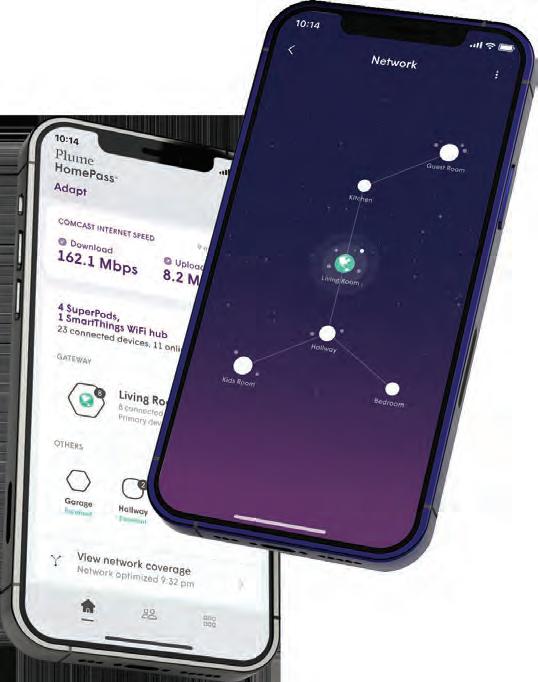
10 Fiber Forward • Q3
© 2022 Plume Design, Inc. All rights reserved.
FBA PRESIDENT & CEO
Gary Bolton
PUBLISHER
Connect2 Communications, Inc.
EDITOR-IN-CHIEF
Doug Mohney
CONTRIBUTING WRITERS
Ariane Schafer
Google Fiber Government Affairs and Public Policy
Chris Champion C Spire VP Government Relations
Edna Preuss
FBA LATAM Chapter Director of Industry Affairs & Member Services
ADVERTISING SALES DIRECTOR
Lucy Green
DESIGNER
Rick Skippon
AT&T’s Fiber Future-Proof Broadband Path
Fiber Broadband Association Public Policy Committee Update

Fiber Connect 2022 Proof of Concept Showcase
Fiber Connect 2022 - Lessons Learned
Fiber Connect 2022 Photo Gallery
Fiber Across America in 2022 –Community Snapshots
Public Safety’s Digital Transformation
The Smart Grid Evolves to Version 2.0
Fiber Connect 2022 – FBA Awards Member Accomplishments
Broadband Infrastructure
The
Join Fiber Broadband Association Today! www.fiberbroadband.org Mark Your Calendars for Fiber Connect 2023! August 20–23, 2023 Kissimmee, FL Subscribe to the Fiber For Breakfast podcast on your favorite podcast platform. 2022 EDITION 3 Table of Contents 07 Fiber Forward • fiberbroadband.org
from the President & CEO
Letter
FBA at Work – The Trusted Fiber Working Group
Playbook
Update –July 2022
In-Home Experience
Best Value Out of Fiber: The In-Home Experience Working Committee
Slack, and Access: FutureProofing Your Future-Proof Fiber Network
America: Fiber Connect LATAM
Rica & Training
Forward Editorial Calendar & FBA Event Calendar 05 09 10 13 16 19 24 26 35 38 40 42 44 47 50 52 58 2023
Importance of Managing the
Getting
Strands,
Latin
–Costa
Fiber




WORRY LESS. BUILD MORE. SAM ADAIR 217.254.0341 • adair@irby.com Our team has a proven record of delivering the results to design, build and support a successful broadband business. Providing a turnkey broadband solution on time and under budget. irbyutilities.com/broadband Feasibility Studies Engineering & Design Network Solutions Materials & Logistics Project Management Customer Support NUMBERS YOU CAN TRUST. 90 Trusted industry leader & utility partner for more than 90 years. 50 More than $50 million in broadband inventory on hand, in stock. 125 125 dedicated broadband professionals working around the clock. 21 Broadband projects are delivered on average 21% under budget.
FBA at Work –The Trusted Fiber Working Group
By Doug Mohney
One of Fiber Broadband Association’s newest organizations, the Trusted Fiber working group was created in late 2021 to ensure the ethical production, distribution, pricing, and security of fiber to protect our nation’s critical infrastructure.
“The Trusted Fiber working group is predicated upon the goal of protecting our nation’s critical communications from black market and substandard fiber,” said Patrick Jacobi, chair of the group and Prysmian Group’s Senior Vice President, Telecom North America. “It has become more timely because of the need and demand for fiber and the supply chain challenges that are coming with that.”
Low-maintenance and energy efficient by design, fiber has a proven operational useful lifespan of many decades with upgrades implemented by simply replacing the electronics on the ends. With the boom in fiber projects triggered in part by the pandemic and fueled by federal and state funding over the next five to 10 years, the Trusted Fiber working group finds itself
of replacing imported equipment and services that pose a national security threat.
“We’re providing guidance from a fiber industry perspective, so the nation doesn’t have to go through another rip and replace program,” Jacobi said. “Let’s get it right the first time.”
What is trusted fiber? The committee is in the process of defining it.
“We’re looking at a lot of different things, a national security perspective, a counterfeit perspective, everything from environmental sustainability to taking into account labor practices and things such as simple quality and long-term performance of product,” said Jacobi. “You start to get into the layers within quality and long-term performance and talk about the specific standards within the industry that can be applied in the US and globally. We are trying to provide guidelines based on standards that are out there rather than creating new ones.”
challenged to support a rapidly expanding industry. Increased demand and the rapid pace of construction for high-speed broadband may provide a climate where “grey market” lowquality or counterfeit fiber may find its way into supply chains and networks.
Preventing the use of substandard fiber in networks is essential to avoid headaches and unforeseen replacement costs. “People can’t afford to install fiber then six to twelve months later or five to ten years later be told that it’s a non-secure product, you have to rip it out and start all over again,” Jacobi said. “We’re working to be proactive rather than reactive.”
Having to rebuild a single network would quickly run into millions of dollars, so avoiding the possibility having to conduct an industry-wide rework program due to substandard fiber getting into the networks is something the fiber industry wants to avoid, given the issues around the Federal Communications Commission (FCC) Secure and Trusted Communications Networks Reimbursement Program, better known within the industry as the “Rip and Replace” program where the FCC reimburses service providers for the cost
The Trusted Fiber working group has been able to gain insight from other supply chain and security efforts going on within other organization as national security considerations continue to rise to the top of the agenda for a number of different industries.
“We’re in the early stages of development, it’s been a nice cross-industry, cross-manufacturer effort,” Jacobi said. “We are all doing our homework to identify standards that are applicable globally because we have a lot of international trade and imports as well as production in the U.S. The end game for us is a white paper providing guidance and dialing into existing applicable international standards.”
Jacobi is encouraged by the collaboration he’s seeing among the companies in the group, which include the industry’s fiber manufacturers. “It’s imperative that we’re able to have good open dialogue. With the broadband build out so strong and coming at us so fast that anytime we can lean on others’ experiences and discuss topics like trusted fiber for the betterment of deployments within the nation, it’s a good thing.”
09 Fiber Forward • fiberbroadband.org
We’re providing guidance from a fiber indistry perspective, so the nation doesn’t have to go through another rip and replace program. Let’s get it right the first time.
– Patrick Jacobi, Trusted Fiber working group chair and Prysmian Group’s Senior Vice President, Telecom North America.
AT&T’s Fiber Future-Proof Broadband Path
By Doug Mohney
While XGS-PON and single-digit gigabit per second broadband speeds are now widely accessible on residential and business networks, market leader AT&T is aiming higher with its recently announced field trial of 25G PON. This next generation access technology field trial is critical to the company’s mission to hit up to 30 million homes by 2025 with a strategic fiber expansion.
“AT&T is investing in the future by putting fiber in the ground, utilizing it for residences, businesses, and infrastructure for things like 5G cell site backhaul,” said Eddy Barker, Assistant Vice President of Access, Design and Architecture at AT&T. “That glass is very, very strategic. Fundamentally, we’re building on our fiber core and demonstrating how, with very minimal incremental investment, we can then expand to more capacity and higher speeds as needed. In 2020, we were one of the first providers in the world to deploy XGS-PON on a networkwide basis. Initially, we did it for gigabit symmetrical services and this year we launched our two and five HyperGig symmetrical services.”
As part of its long-term network strategy, AT&T has moved to passive optical in its outside plant, removing active electronics. “When we do need a speed or capacity upgrade, it’s just a matter of upgrading the electronics in the central office or sometimes at the customer premise,” said Barker. “Future upgrades can be selectively implemented very inexpensively as the new technology becomes overlaid on the existing fiber investment.”
Based on the progression of components, Barker anticipates the overall 25G PON ecosystem with multiple vendors to mature in the second half of 2023 with the latter part of 2024 when 25G PON starts to be a candidate to enter its network from a services perspective.
Barker noted AT&T will be able to support the future deployment of 25G within its network as a natural part of doing business. “We’re seeing heavy take rates with AT&T Fiber and making necessary capacity augments in our metro and core networks to provide our customers with a great internet experience,” he said. “Making incremental capacity investments
Moving to offer symmetrical multi-gig speeds this year comes from a mix of factors, including residential and business demand and AT&T’s use of a converged fiber network to support multiple types of customers.
“Telecommunications companies such as AT&T are always looking forward to new technologies to prepare for the future in order to meet customer demand and this includes developing new access technologies,” said Barker. “For example, when we deploy 25G PON, we could first target businesses which require 10 Gig+ symmetrical services. We would overlay those on a case-by-case basis across our embedded fiber infrastructure as you had demand.”
Upgrading from today’s XGS-PON-based access network to 25G and faster will be relatively straightforward. Earlier this year, AT&T successfully conducted a 25G PON trial in Austin, Texas, overlaying 25GS-PON wavelengths over existing XGS PON signals on a single fiber. XGS and 25GS PON customers coexisted on the existing fiber plant without difficulty.
and keeping ahead of those growth curves in your busy traffic periods are absolutely critical. It’s a great problem to have.”
Planning for the future network speeds doesn’t stop at 25G but is a continual process that takes years to establish and formalize the next generation of technology standards. “The ITU standardization body is working on a 50G PON symmetrical standard right now and driving toward 100G eventually. All those standards are going to come with time and face different challenges on the technologies and the economics.”
AT&T will continue to be flexible in how it adapts and deploys next generation technologies. “One of the things that I’ve been very vocal about in comparing 25G versus 50G optical technologies is that these are simply different tools in our toolbox,” Barker said. “We’ve made a statement that we want to be the best broadband provider in the United States. Therefore, optical fiber and all the services that use it are a strategic investment for the future.”
10 Fiber Forward • Q3
AT&T is investing in the future by putting fiber in the ground, utilizing it for residences, businesses, and infrastructure for things like 5G cell site backhaul.
– Eddy Barker, Assistant Vice President of Access, Design and Architecture at AT&T
Simplifying Broadband Deployments
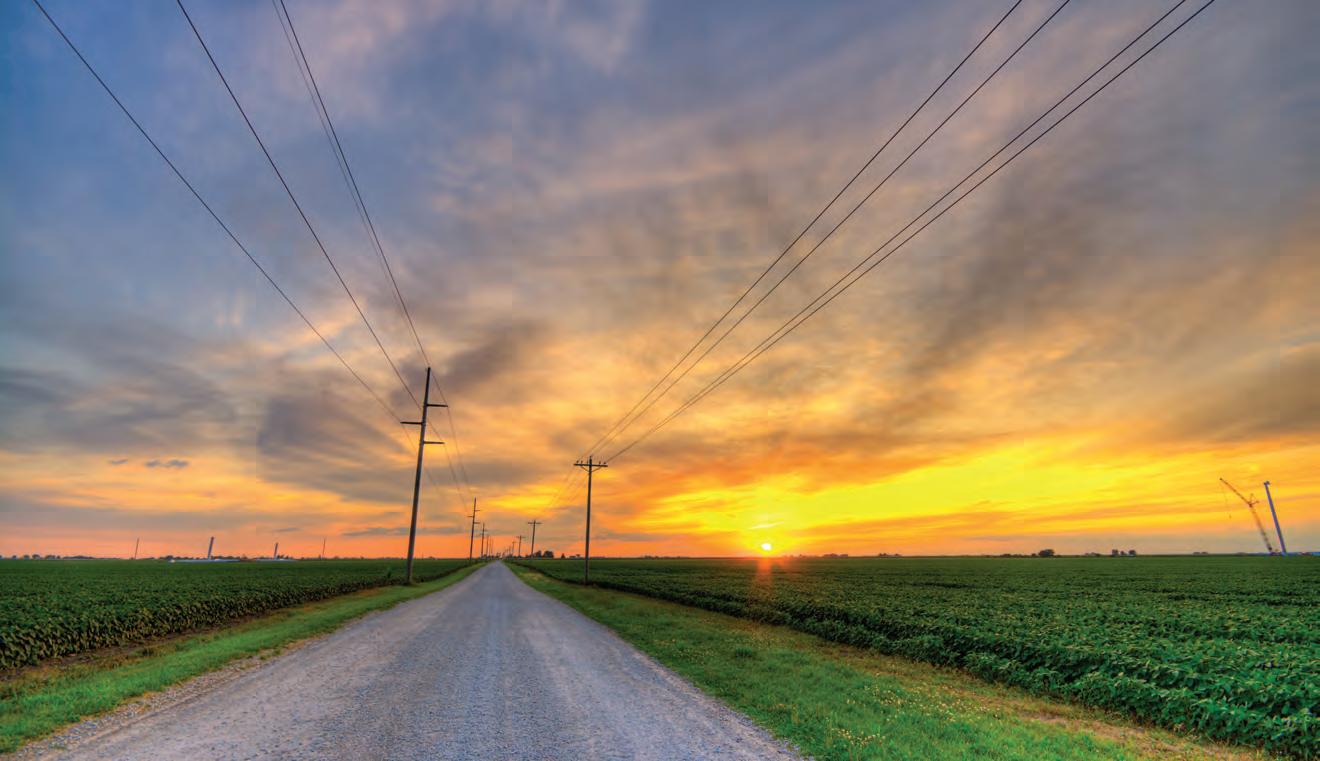
With years of experience in all facets of fiber infrastructure, Wesco delivers innovative supply chain solutions for your fiber network deployment project. Wesco utilizes our best-in-class technology and industry leading experience, working with you to deliver a full suite of customizable supply chain services to fit the unique challenges of your fiber build. From simple and straightforward to complex – our distribution and logistical services including consultation, asset management, eProcurement, VMI, warehousing and project management, all scalable to fit your needs.
• Supply chain management
• Inside plant products
• Outside plant products
• Wireless solutions
For more information on our innovative fiber solutions, visit: Wescodi.st/broadband
10 Fiber Forward • Q3
221064A001 © 2022 Wesco International
Wesco.com
BUILDING A SUCCESSFUL FIBER NETWORK
About us
Ervin Cable Construction, LLC has been constructing the nation's largest telecommunications systems for the last 40 years.

At Ervin Cable, we are continuously expanding our capabilities within the industry. Our business now operates specialized design and engineering offices in addition to our regional construction facilities.
As a turnkey provider, we have the infrastructure to efficiently and effectively meet our customer’s needs from start to finish.
our services
From 5G to rural broadband deployment, we are here to serve all our customer’s needs. Our highly trained and professional workforce has successfully and timely completed some of the largest FTTH and fiber network construction projects in the country.
Even before a global pandemic, Ervin Cable had been constructing fiber networks in rural America. After it was realized that fiber was not a luxury but a necessity, we continue to do our part in getting fiber installed to the least served areas of the country.
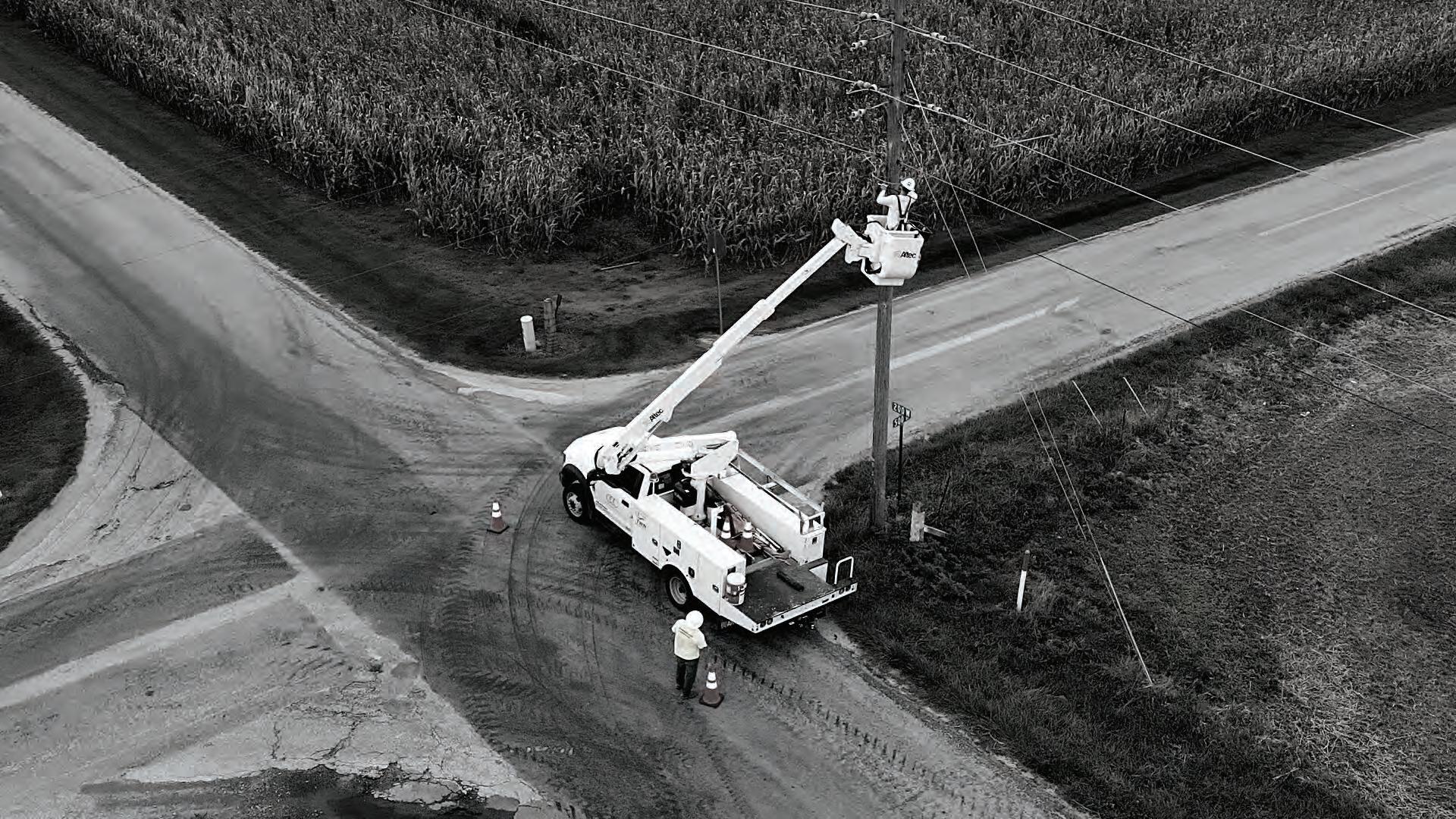
10 Fiber Forward • Q3 corporate@ervincable.com 270-333-3366
Ervin Cable Construction LLC is your turnkey network deployment provider.
450 Pryor Blvd Sturgis, KY 42459
Fiber Broadband Association Public Policy Committee Update
By Co-chairs: Ariane Schafer, Government Affairs & Public Policy,
VP Government Relations, C Spire
A whirlwind of activities has taken place over the past few months with several significant federal policy items taking place.
SpaceX Starlink satellite RDOF award denied
On August 10, the Federal Communications Commission rejected SpaceX’s Rural Digital Opportunity Fund (RDOF) long form application, denying the company the $885.5M award announced on December 7, 2020. The action by the FCC, rejecting SpaceX’s Starlink from RDOF funding, provides clarity and a path forward for fiber to close the digital divide, while returning $885.5M of this precious funding back into the RDOF fund for more appropriate broadband.
Around 640,000 families were to be relegated to higherlatency satellite service as a result of the 2020 RDOF auction results. Further, as these families were designated in “Starlink locations,” they were at risk of being redlined from being eligible for fiber broadband from the $42.45B NTIA BEAD broadband infrastructure funding and other federal, state, and local broadband programs.
In early 2021, the Fiber Broadband Association and NTCA commissioned a study by Cartesian to develop a model that the FCC could use to evaluate the Starlink network and its ability to meet its RDOF broadband commitments. This research found that best case, Starlink would fail to meet its minimum bandwidth requirements for 56% of its RDOF subscribers in a forecasted low demand scenario by 2028. More locations would be negatively impacted if RDOF usage was higher, or SpaceX launched fewer satellites by 2028.
Further, the analysis showed the FCC performance testing used for CAF (Connect America Funding) may fail to detect capacity issues given the dynamic nature of the Starlink network. The FCC further observed Ookla data reports that Starlink’s speeds have been declining quarter-over-quarter, including upload speeds that are well below the minimum 20 Mbps requirement. In short, these 640,000 “Starlink” households were at risk of being relegated to the wrong side of the digital divide.
The August 10th FCC announcement was a bold and decisive action that provides clarity and closure as we work together to close the digital divide once and for all.
BEAD NOFO Out, Broadband Infrastructure Playbook Updated
In July, the Broadband Infrastructure Playbook was updated to reflect the NTIA Broadband, Equity, Access, and Deployment (BEAD) Program Notice of Funding Opportunity (NOFO) information released in May. The July 2022 update provides states with the latest information as they embark on closing the digital divide and build highspeed, future-proof fiber infrastructure that will last for generations. This update is especially timely as deadlines approach and the work is set to begin as states look to develop a five-year plan.
FCC – Section 706 Notice of Inquiry –25/3 Mbps Change
The FCC soon will launch its annual notice of inquiry where it evaluates the broadband performance benchmark of 25/3 Mbps. FCC Chairwoman Jessica Rosenworcel has proposed the standard be moved to 100/20 Mbps in the proceeding with a longer-term national goal of 1 Gbps/500Mbps. The Fiber Broadband Association plans to participate, offering guidance on why fiber is the only option to meet these short-term and longterm goals. Comments on the Notice should be due in late September or early October.
Next USDA RUS ReConnect Round Opening
The next round of U.S. Department of Agriculture (USDA) ReConnect funding opens for applications in September 2022 and closes in early November 2022. This round will distribute $1.1 billion in loans and grants. The most recent notification is on the RUS website.
State Broadband Leaders Network (SBLN) Biannual Summit
Hosted by NTIA, SLBN took place August 3-5, with all 56 states and territories represented along with 35 NTIA staff in attendance. Fiber Broadband Association President and CEO Gary Bolton spoke at the event along with
13 Fiber Forward • fiberbroadband.org
Google Fiber, and Chris Champion,
10 Fiber Forward • Q3
representations from 10 other associations who were invited to discuss how NTIA, states, and industry can work best to close the digital divide.

NTIA will have 46 regional staff distributed throughout the country, nearly a person in every state. State broadband offices have staffed up. Some officers are eager to receive support from the Fiber Broadband Association to move forward in securing BEAD funding and building out broadband networks. FBA stands ready to be a resource and help educate state broadband staff on key issues such as the “Build America, Buy America” act, affordability, sustainability, and workforce.
The Fiber Broadband Association’s Regional Connect events have enabled it to develop good relationships with states, with great support from local broadband offices.
Future FCC Actions
There are two FCC activities expected to occur by the
end of the year. The FCC will issue a Future of Universal Service Fund report as part of the IIJA, discussing the key issues of future distributions and funding for the e-rate, telehealth, and other programs and potential future contributions for USF. An update to the FCC’s Alternative Connect America Model (A-CAM) is expected to be issued by the end of the year, updating standards relevant to the BEAD program.
Legislation Update
There are several bills that the Fiber Broadband Association’s Public Policy Committee is tracking, including the Proper Leadership to Align Networks for Broadband (PLAN Broadband Act) that would require the president to develop a strategy to close the digital divide in coordination with the 14 agencies with broadband funding programs. The Public Policy Committee is also tracking the Grants to Rapidly Invest and Deploy Broadband Act of 2022 (GRID Broadband Act) that facilitates middle mile projects and would be jointly administered by NTIA and the Department of Energy.

15 Fiber Forward • fiberbroadband.org
Demonstrating Limitless Possibilities with Unlimited Capacity Fiber Connect 2022 Proof of Concept Showcase
By Doug Mohney
The power of fiber broadband is much more than simply delivering high-speed internet access to homes and businesses. An ecosystem of service providers and equipment vendors are delivering pioneering applications and working to close the digital divide by leveraging leading-edge technologies based on fiber’s secure, lowlatency, high-bandwidth capabilities.
At Fiber Connect 2022 in Nashville, the Fiber Broadband Association featured six demonstrations in its first Proof of Concept (PoC) Showcase to illustrate ground-breaking collaborative projects between member companies and their partners that demonstrate why fiber is more robust, reliable, and best-suited over alternative technologies to support the applications and services of today and tomorrow. Nine companies participated in this year’s Showcase.
“Amazing things come from collaboration,” said Gary Bolton, President and CEO of the Fiber Broadband Association. “It was great to see our members and their partners come together to present the next wave of innovations that fiber can support. All of the participating companies should be applauded for their excellent demonstrations and jobs well done.”
Vendors and attendees alike found the PoCs refreshing and informative. “Attendees commented that the PoC illustrated very well how all elements of Calix’s Revenue EDGE solution combine to serve our customers at every business stage, and beyond that were excited to learn about the value-added services we have on our roadmap,” said Megan Powell, Director, EDGE Suites Product Marketing, Calix. “One visitor mentioned that the Calix PoC helped to drive home the unique advantage that they have as a broadband service provider to put new managed services in front of their subscribers that truly enhance a connected lifestyle and smart home and provide important services to their community.”
Three of the six PoCs received awards for demonstrating superior impact either on the industry as a whole or to the communities they serve.
Most Innovative Award
Nokia received the Most Innovative Award for its “Fiber for Our Broadband Future Now” demonstration, developed by Nokia Bell Labs and featuring the first 100Gb/s broadband display to service providers in the U.S. using 100G PON technology.


16 Fiber Forward • Q3
Ciena’s Vini Santos is presented with the Game Changer Award for the company’s joint Proof of Concept with Plume and Benu Networks at Fiber Connect 2022. The award was presented by FBA Vice Chair & Fiber Connect Conference Chair Joseph (JJ) Jones and Omdia’s Julie Kunstler and Jaimie Lenderman. Source: FBA.
Nokia demonstrates its Proof of Concept at Fiber Connect 2022, titled, “Fiber for our Broadband Future Now.” Source: FBA.
The PoC showed how fiber capacity increases from GPON to 100 Gb/s and beyond simply by adding wavelengths to a single strand of glass, providing future-proof scalability for decades through simple electronics upgrades. It explored new services and use cases that can converge onto a high-speed fiber connection by utilizing 100G PON, such as ultra-high-speed business services, 5G, and 6G transport, to spark new opportunities for consumers, businesses, and communities. Conducted on live equipment, the PoC showcased how with additional wavelengths and new technologies fiber can unlock the capacity of the networks being built today for the benefit of generations to come.
Best Community Impact Award

Calix received the Best Community Impact Award for its “Deliver a Superior Subscriber Experience in a Rapidly Changing Environment” PoC. The equipment manufacturer has invested $1 billion over 11 years into its leading end-toend platforms, enabling broadband service providers to seamlessly layer value-added subscriber services on top of their managed Wi-Fi offerings.
Value-added new services offered by Calix with service providers are designed to meet subscribers’ evolving demands. This PoC effectively illustrated the value of advanced network security, connected home camera services, advanced parental controls, AI-powered social media monitoring, as well as damage protection for the dozens of smart devices in most households.
“We are thrilled for the recognition of the PoC award,” said Powell. “The feedback from attendees validates our view that managed services represent the future of growth opportunities for broadband service providers.”
Game Changer Award
The Game Changer Award was presented to the team of Ciena, Plume, and Benu Networks for their “Supporting Cities to Get Smarter and More Connected with an Open and Scalable Residential Broadband Solution” PoC. Together, the companies demonstrated how a city can implement a next-generation network using an open, optimized, and highly-scalable cloud-based solution. The PoC supports city communication requirements to become smarter and more efficient while providing high-capacity broadband services for schools, libraries, and residences in urban, suburban, and rural areas.
“The Fiber Connect 2022 Proof of Concept (PoC) Showcase afforded us an amazing opportunity to demonstrate firsthand the remarkable possibilities that innovations in broadband technology bring to bear through openness, scalability, and sustainability,” said Vini Santos, Industry & Solutions Marketing, Ciena. “Through the PoC, we were able to connect face-to-face with our Fiber Connect cohorts and illustrate how cities and communities can get connected, bridge the digital divide, and ignite a digital future for all.”
And The PoCs Go On
But the PoC showcase wasn’t limited to three companies. Calix, COS Systems, and Lit Communities presented “Cutting-Edge Technologies Create Perfect Storm for Health Care Access and More in Medina County, OH,” showcasing collaboration between the three to deliver a customer self-driven online marketplace and zero touch automatic provisioning of services, including secure, stable connections with a local healthcare system and remote telehealth services.
Presented by DZS, “Enabling 5G, Smart Cities/Spaces, and IoT Services with Network Edge Transport and 100/200/400G Coherent Optics” demonstrated how transport capacity at the edge of the network can be transformed to meet the bandwidth requirements and densification driven by the deployment of 5G services for consumers, smart cities/spaces, and vertical industry/IoT applications. The PoC showcased how technologies that are ordinarily present in the network core (terabit-class L2/3 routing and tunable coherent DWDM optics) now have a role at the edge of the network in cell site routers and for environmentally hardened fronthaul/midhaul/backhaul at the 100G level and above per site.
In the “Multi-Service, Converged, Broadband Aggregation” PoC, IP Infusion illustrated how an open, router platform hosted on white box hardware can readily aggregate multi-service traffic at scale (32 Gbps to > 8 Tbps and higher) from a variety of multi-vendor Optical Line Terminal (OLT) form factors based on IP Infusion’s OcNOS common software platform. Benefits of the platform include significantly reduced CapEx, OpEx, and management costs, while facilitating adoption of best-of-breed technologies.
17 Fiber Forward • fiberbroadband.org
FBA Vice Chair Fiber Connect Conference Chair Joseph (JJ) Jones and Omdia’s Julie Kunstler and Jaimie Lenderman present the Best Community Impact Award to Calix’s Greg Owens for the company’s Fiber Connect 2022 Proof of Concept. Source: FBA.

Fiber Connect 2022Lessons Learned
 By Doug Mohney
By Doug Mohney
Fiber Connect 2022, the Fiber Broadband Association’s annual meeting, took place at a time of significant advancement for the industry. Keynote speakers from around the country brought their wisdom to share with the 3,000 attendees in Nashville, incorporating knowledge gained over the past few years from COVID’s impact, rising local and state experience in broadband policy, and the historic infusion of federal funding through multiple programs.
Welcome to Tennessee
Senator Bill Hagerty was in Nashville to welcome Fiber Connect to his home state and hometown, and offered praise to the industry.
“It’s my great privilege to be with you today, to thank you for what you’re doing and for your advocacy,” said Hagerty. “The pandemic has actually underscored for everybody in America how critical broadband access is. I can’t tell you how many times I spoke with mothers who are driving their kids to McDonald’s to download their homework because they didn’t have access at home. I think it really forced a lot of us to realize how important it is for our kids, but also for our jobs. So many people working from home relied on broadband access to do just that.”
Tennessee has been an early adopter in bringing broadband to several of its cities, including Chattanooga, providing a huge competitive advantage for that part of the state to recruit businesses and bring in jobs. Working with local communities and service providers when Hagerty was Commerce Secretary for the state, Tennessee became the number one state in the nation for creating foreign jobs and foreign direct investment for two years in a row. “I hope this example will be carried throughout this nation,” he said.
NTIA – Broadband More Than the Media
Andy Berke, NTIA Special Representative for Broadband, noted he clocked a lot of frequent flier miles as the agency gears up to distribute $54 billion in BEAD funding.
“I’m in my twenty-first state in about four months,” Berke said in his remarks at Fiber Connect’s opening session.
“It’s nice to be in a place where you can order sweet tea and fried chicken.”
Berke emphasized the broadband impact on individuals and communities by talking about Anna, an 87-year-old Native American woman he learned about during a trip to Arizona. “During the pandemic, she decided she wanted to learn how to use the web and sell her creations online
19 Fiber Forward • fiberbroadband.org
NTIA’s Andy Berke is interviewed by FBA Board Member Ben Moncrief during a Fiber Connect 2022 keynote on bringing internet to all. Source: FBA.
because she was an expert [seamstress],” he said. “She had become depressed during the pandemic because she felt she couldn’t connect with anyone. She felt if she could learn some [internet] skills, do her sewing, and come back and sell it online, she could have more purpose… We think often about the internet as being something that young people really thrive with. The truth is many of our seniors feel left out. If you’re going to have any kind of commerce, whether you’re a big business, or a one-person business like Anna, you get on the web and that opens up new markets and territories for you to sell.”
But it’s not just commerce that broadband is now intertwined with. “There is a social aspect to the web that we cannot underestimate in 2022, as more and more of our social life, the way that we interact with family and friends and neighbors comes online, as well as the way that we interact with our government,” Berke said. “We know that the internet is such a big piece of equality. But equality doesn’t happen on its own. Technology brings the promise of equality, but not the reality.”
“Bipartisan funding support for broadband along with the Biden administration’s push for broadband have delivered a way to turn dreams into reality,” Berke stated. “I don’t want people in this crowd to underestimate the President of the United States. Joe Biden has said that every American will have access to affordable, reliable high-speed internet. To have the President of the United States incorporate this into his agenda as one of the most important things that he’s going to do while he’s in office is really an amazing and transformative moment.”
Bridging the Digital Divide –Putting in the Work
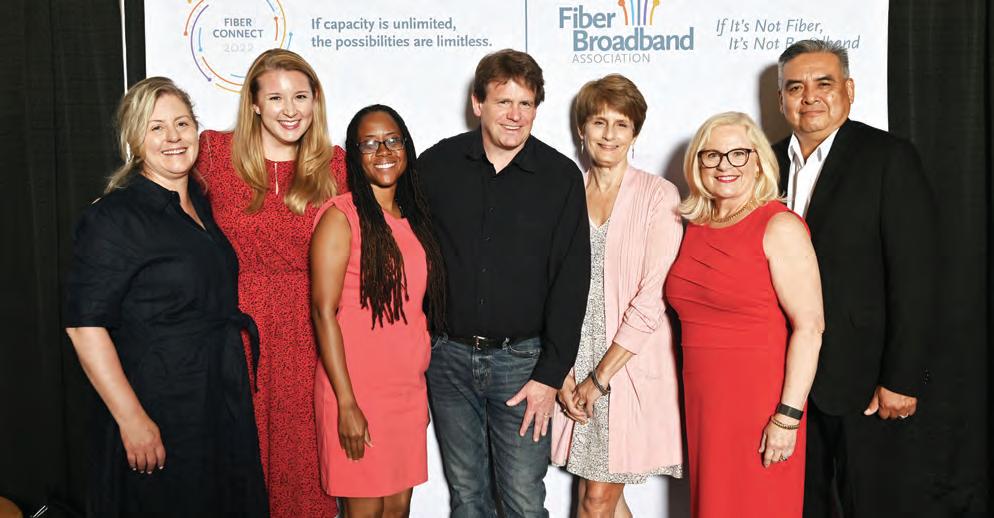
The “Federal Focus: Bridging the Digital Divide” panel following Hagerty and Berke was quick to note that there’s a lot of work to be done in the years ahead.
“We are on the verge of making the most consequential fiber investments for both public and private resources in the history of the United States and addressing a massive part of our digital divide challenge,” said Joanne Hovis, President, CTC Technology and Energy as she introduced the panel. “But we’re not there yet. Even when we finish the current round of investments, both public and private, the ones that are coming in the next few years, there will still be digital divides that we have to address as a nation.”
Providing high-speed broadband will continue to be a challenge in rural areas, with the U.S. Department of Agriculture’s Rural Utilities Service (RUS) recently changing its funding structure to accommodate the issues involved in reaching low-density population areas.
“We’ve been working on high-speed internet for a long time, since I was in high school,” said Xochitl Torres Small, Under Secretary for Rural Development, U.S. Department of Agriculture. “To me, one of the key factors when it comes to the digital divide is when you’re working in rural communities, it’s harder, there’s less economies of scale to reach that last mile, it’s a whole lot more investment to get to that last house. You’ve got to find ways to make that worth the investment. Being able to prioritize in places where there’s tribal investments or socially disadvantaged folks that we’re trying to reach, being able to have no
20 Fiber Forward • Q3
The Fiber Connect 2022 “State of the States”. Source: FBA.
match [required] in the Bipartisan Infrastructure Law for ReConnect is very exciting, because it will help us bridge that digital divide that has extra costs that makes it very difficult in rural communities.”
Better understanding of grant programs at the state level will be key, according to vendors who are watching the process of more money start to flow in through ARPA and soon with BEAD. “From our standpoint, there’s a lot of education that needs to happen, both with the federal agencies and the state broadband offices who are understaffed and desperately trying to hire enough people to manage these programs,” said Lori Adams, Senior Director, Broadband Policy and Funding Strategy, Nokia.
The Pew View
On Tuesday, Kathryn de Wit, Project Director, Broadband Access Initiative, Pew Charitable Trusts took the stage to discuss building the fiber future today and the critical role states and local leaders must play in the months and years to come.
“I think it’s really important to take a step back and talk about why we are making these investments in fiber,” said de Wit. “What Congress has now seen and what states have been seeing for years is the message that all of you have been sharing and that is fiber is the thing that’s going to guarantee economic and social benefits for communities across the country for years in the future.”
The differences between state broadband programs are based upon the unique characteristics of each state, Pew found, considering geography, population density, median income, and other factors, creating different solutions across the country from Maine to Wyoming. State decisionmakers were very effective in using policy to address the digital divide, using policy tactically to increase the accountability and oversight of public dollars to target parties or populations, improve the accountability of public funds, and to prioritize funding and specific technologies.
“A few other things that we noted include seeing increasingly bipartisan solutions across the board, largely led by rural leaders,” said de Wit. “They were prioritizing funds towards rural communities but what immediately came after that was ‘We know that this is not just a problem in rural America’ and they were prioritizing investment in fiber… They use fiber as a lifeline for keeping their communities intact, combating the brain drain, making sure that people can age in place, access health care, access to workforce development opportunities, and that they wish to keep revenue in the state. We talked to lawmakers from coast to coast who repeatedly said that if they didn’t have fiber connections in their communities, their towns would die.”
De Wit said everyone needs to be engaged in broadband planning, especially with the NTIA BEAD funding process
starting. “All of this ultimately comes down to advocacy. Despite the fact that we have seen states move towards the focus on fiber, and despite the fact that all of us in this room know why investing in fiber is so important, we still have elected officials in Congress who say, ‘Do we need it?’”
Statements From the States
Monday’s “State of the States: Ensuring Fiber Reaches Everyone” keynote panel dove into the many factors state and tribal governments are facing as they ramp up to leverage BEAD money.

For some, the absence of capital funding has led to being creative with limited resources. “When you don’t have money, you plan,” said Peggy Schaffer, Director of ConnectMaine. “One of our strengths in Maine is that we have had a community planning program in place for about seven years now and we’ve provided funding to well over 300 communities statewide to figure out broadband solutions for those areas. This new [NTIA] money continues to emphasize that and the importance of the community voice in community planning.”
Reaching everyone who needs broadband was a topof-mind concern for panelists, especially since there’s more to bridging the digital divide than simply delivering the network. “In our space, there’s been a conversation around the rural-urban divide,” said Dr. Tamarah Holmes, Director, Office of Broadband and the Virginia Department of Housing and Community Development. “Rural has
21 Fiber Forward • fiberbroadband.org
TiVo’s Kevin Lenhart at Fiber Connect 2022 on evolving customer preferences for video entertainment and fiber broadband growth opportunities Source: FBA.
primarily been focused around infrastructure. In the urban communities, it’s been around affordability.”
States are planning to do more than simply light up networks to close the digital divide as BEAD funding moves forward. “I look at this as a three-legged stool and access is only the first component of that,” said Jessica Simmons, Deputy Chief Information Officer for Broadband and Special Projects, Georgia Technology Authority. “Affordability is the second and then education and literacy is the third. If we just focus on deploying the infrastructure and we think we’re done, we’ve absolutely missed the mark because we’re not paying attention to subscription rates. If people cannot afford access, we need to find resources to be able to help train them to use those devices and the various uses of the internet. I think we really have to look at these threads hand in hand.”
From the viewpoint of tribal nations, sustainability is a concern. “A lot of these tribes are building these new networks in areas that are high cost,” said Godfrey Enjady, President of the National Tribal Telecommunications Association. “When you build this infrastructure and there’s no funding to run it, you need to make sure these companies keep running two, three, four years down the road.”
Partnerships are key for expanding coverage, especially when it comes to bringing together local governments and commercial service providers. “Because of the nature of [Virginia] state rules around procurement, we put the localities in the driver’s seat,” said Holmes. “I literally do match.com relationships between our leadership from local governments and our leaders from
our internet service providers within the Commonwealth and partner them physically in a room, like speed dating for broadband.”
TiVo’s Video Data Mining
Tuesday’s first keynote session, “Evolving Consumer Preference for Video Entertainment and the Growth Opportunities for Fiber Broadband Operators,” featured Senior Vice President and General Manager of Pay-TV Business at Xperi Corporation—the company that owns TiVo--Kevin Lenhart. The company is leveraging machine learning and its entertainment expertise to deepen engagement with content and services.
TiVo has collected over a decade worth of consumer video interaction data along with conducting consumer surveys. “We’re in a unique position to do this, not only because of the video trend reports that we have, but because of the millions of devices that we have out there in the ecosystem from a streaming video perspective, direct to consumers, or more interestingly to our video service provider customers around the world,” Leinhart said. “The good news is, and I’ll spoil the first data for you, viewership is up. There’s a growing demand for video entertainment measured in hours per day that people are choosing to consume video content.”
The way people are consuming content and the types of content they consume are continuing to evolve. “Traditional legacy pay TV is absolutely being disrupted. Streaming video and all the great new content choices that consumers have in front of them presents a whole lot more choice and options,” Leinhart remarked. “The good news is it’s increasingly competitive across the board. That presents opportunities to differentiate for consumers.”
On average, people in the U.S. spend 4.6 hours per day enjoying video entertainment, with half their time spent on live TV and a growing amount of time spent on premium Video on Demand (VOD) services. TiVo believes video service providers are in a unique position to potentially solve the challenges of unifying the consumer worlds of premium VOD services with live video.
“Consumers are mixing and matching VOD and live TV to get the perfect mix for them of what a video experience should be, but people’s wallets and their ability to handle content across all of these different services is not growing as quickly as the demand for high-quality video,” Leinhart told the audience. “We’re starting to see a bit of a saturation point in the number of services people utilize, or it’s not going quite as rapidly as it has in the past. Within the total bucket in the U.S. on average, people are using about nine video services every month to get the content that they want to enjoy. That’s a mix of paid and free or ad-supported content within that level.”

Around 73% of respondents told TiVo that they felt “pretty good” about the number of content service they subscribed
(cont. on page 54)
22 Fiber Forward • Q3
CostQuest Associates, Inc.’s Jim Stegeman and CTC Technology & Energy’s Joanne Hovis discuss bridging the digital divide during a Fiber Connect 2022 keynote panel. Source: FBA.

Fiber Connect 2022 Photo Gallery
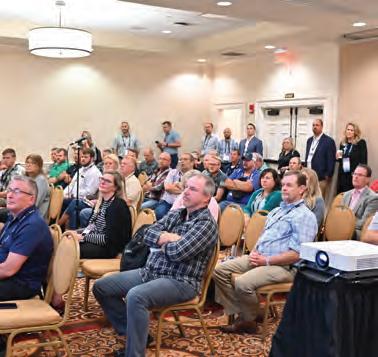




The Fiber Broadband Association gathered its members for its annual Fiber Connect event in Nashville, Tenn., June 12-15. The event surpassed all expectations in terms of speakers, content, sponsors, exhibitors, and attendance. Here we have collected images to reminisce about the amazing event, who was there, the content delivered, and what we learned.

24 Fiber Forward •
Q3
for all
Christopher Ali, Associate Professor at the University of Virginia and author of Farm Fresh Broadband, signs copies of his book at Fiber Connect 2022.
Source
photos: FBA.
FBA leaders officially open the Expo Hall at Fiber Connect 2022.
Adtran’s Robert Conger explores fiber’s economic benefits alongside Google Fiber’s Jessica George in a keynote panel moderated by Fierce Telecom’s Linda Hardesty at Fiber Connect 2022.
Breakout sessions at Fiber Connect 2022 were packed full of great content and attentive audiences.
FBA President & CEO Gary Bolton welcomes attendees to Fiber Connect 2022 and builds excitement for the week ahead.
The FBA Women in Fiber group continues to grow year-over-year and gathered for a luncheon at Fiber Connect 2022.
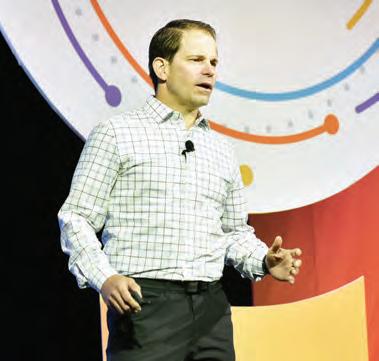


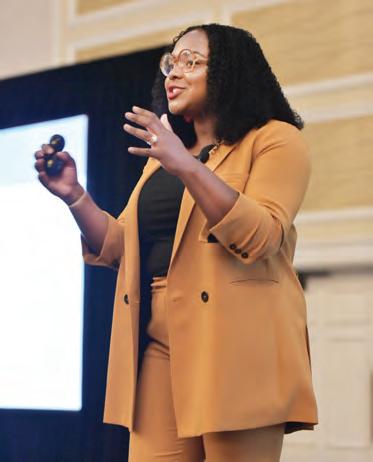
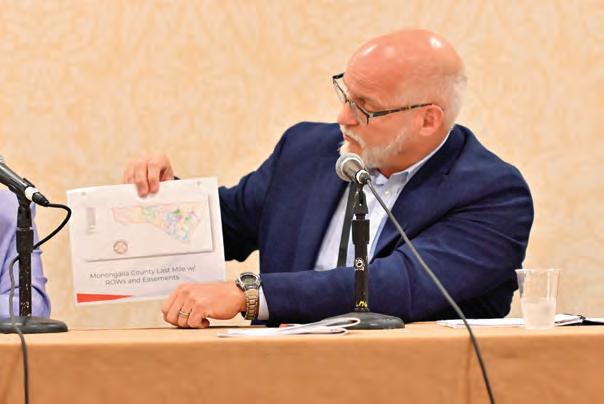

25 Fiber Forward • fiberbroadband.org
Traffic in the Fiber Connect 2022 Expo Hall kept a record number of exhibitors busy during the event.
Brittany Cole, CEO of Career Thrivers, speaks to a full house at the Fiber Connect 2022 Women in Fiber Luncheon.
Brendan O’Boyle from Preformed Line Products leads a demo at the OpTIC Path (TM) Train the Trainer Course at Fiber Connect 2022.
Sean P. Sikora from Monongalia County, WV, presents during his pre-conference panel on the role of public/private partnerships at Fiber Connect 2022.
UTOPIA Fiber’s Kimberly McKinley and The Sasha Group’s Elizabeth Cates tackle marketing strategies for new fiber deployments at a Fiber Connect 2022 preconference session.
Meta’s Randy Brogle presented at Fiber Connect 2022 on connecting the Metaverse.
Source for all photos: FBA.
Fiber Across America in 2022 –Community Snapshots


 By Doug Mohney
By Doug Mohney

With nearly one hundred thirty billion dollars of public funding flowing into broadband projects over the next five years Fiber Forward talked to fiber providers across the country to get a feel for where they started, how they are doing today, and what they are planning to do in the near future.


We spoke with eight providers, a mixture of companies with diverse business organizations and geographies, but with a common goal to leverage the possibilities created by fiber broadband. Each one has a unique history on how it got into the business of fiber broadband. They include municipalities, utilities, phone cooperatives, and privately-owned businesses providing service from the Garlic Capital of the World in California to the Eastern Shore of Virginia where a new rocket factory will help the community take off.
Some have been slowed by COVID supply chain difficulties while others have continued their build plans without

























problems. One said it was starting to see workforce competition between itself and other local providers. Nearly all were in the process of putting in more fiber and looking forward to working with their state broadband offices to obtain federal and state funding.


One trend that emerged from our discussions is that those communities that invested in fiber five or more years ago are now positioned to branch out from their initial service areas and provide broadband to neighboring communities with municipalities in need of faster, more reliable service. Having seen the numerous benefits of high-speed, lowlatency broadband, these neighboring communities are offering political and financial support to facilitate getting fiber into town.
Fiber Forward is pleased to present these communities’ impressive stories, grouped by geographic region: East Coast, Middle America, and West Coast.



26 Fiber Forward • Q3
Jersey Shore, PA Downsville, WI
San Martin, CA
South Hadley, MA
Exmore, VA
Palmer, AK
Stillwater, OK Jonesboro, AR
We have stock and access to full and partial reels of loose tube (armored and non-armored), flat drop (toneable and non-toneable), Ribbon, Micro, ADSS, Indoor Plenum/Riser, and multimode fiber optic cable from several manufacturers.




Adams Cable Equipment Adams Cable Equipment CALL US TODAY! 913.888.5100 9700 Widmer Road | Lenexa, KS | 66215 www.AdamsCableEquipment.com
Adams Cable Equipment is a strategic distributor of fiber optic cables and materials for modern telecommunications and fiber optic networks. Relationships with manufacturers and providing the highest quality cables around means ACE can be a valuable asset for your next project. Our familiarity in the industry and years of expertise will give your company peace of mind when sourcing materials.
FULL
• Armored
• Non-Armored • Ribbon • Flat Drop
• Flat Drop Non-Toneable • Indoor Cable Plenum
• Indoor Cable Armored • Indoor/Outdoor Plenum
• Indoor/Outdoor Riser • Indoor/Outdoor Armored Plenum Rated • Corning • Teldor • Prysmian • Wavenet • OFS • Wave Optics • GAON • Lexington Ames • 12 • 24 • 36 • 48 • 72 • 96 • 144 • 288 • 432 • 576 • 864 • 1728 • 3456
AND AVAILABLE COUNTS: FIBER DISTRIBUTION
& CUSTOM LENGTHS AVAILABLE UPON REQUEST!
Fiber OSP
Toneable
Rated
Rated
WE HAVE ACCESS TO:MANUFACTURERS














10 Fiber Forward • Q3
EAST COAST
South Hadley Electric Light Department (SHELD) / Fibersonic Finding Personnel Next Door
Quick Facts
• Electric Utility
• Headquarters: South Hadley, Massachusetts
• Fiber subsidiary: Fibersonic
• First residential fiber: 2019
• Homes passed as of interview: 4,000
• Customers as of interview: 1,500
• Who we spoke to: Sean Fitzgerald, General Mgr., SHELD
• Unique points: One service, one price; workforce competition
This year, its Fibersonic broadband subsidiary will expand to the neighboring Massachusetts “Hill Towns” of Leverett and Shutesbury, adding another 1,400 customers who do not have access to broadband. Taking a cue from Greenlight Community Broadband in Wilson, N.C., Fibersonic will offer a single broadband speed – 1 Gbps symmetrical – at one price to keep things simple and easy.

Unlike some electric utilities, SHELD deployed broadband first and will add smart grid functions as it goes along.
“We’re installing Advanced Metering Infrastructure now,” said Fitzgerald. “We’ll be able to leverage AMI to do outage mapping on our fiber network and eventually evolve to Smart Grid in a few years. We are dabbling in things like controlling electrical vehicle charging stations right now.”
Fitzgerald started work with Fibersonic in 2017. “I was recruited out of Westfield (Gas and Electric) in 2016,” Fitzgerald said. “Today, there’s competition among the municipal light companies in the area to expand their service footprints and it has heated up the job market for experienced broadband people in our region.”
Pennsylvania Telephone Company (PTC)
Happy Acquisition, Bad Supply Chain
Quick Facts
• Privately owned phone company, subsidiary of New Lisbon Holdings, Inc., New Lisbon, Indiana
• Office Location: Jersey Shore, Pennsylvania
• First residential fiber: 2021
• Homes passed as of interview: 700
• Customers as of interview: 850 (telephone and fiber)
• Who we spoke to: John Greene, Chief Executive Officer, NLBC
• Unique points: Handshake acquisition, COVID supply problems
How does a small, privately-owned phone company in Indiana end up in Pennsylvania? New Lisbon had been looking for new opportunities but found itself looking farther afield than its immediately adjacent territories.
Like many municipality-owned utilities, South Hadley Electric Light Department (SHELD) traces its history back to over a century of service to the community. In 1913, the City of South Hadley bought the electric generating and transmission facilities from a private company. SHELD first invested in fiber in 2006, initially delivering broadband services to the municipality and some commercial customers and starting to provide services to residential customers in 2019.
SHELD got into residential fiber because the local incumbent was not providing reliable broadband service. “Comcast built its plant 30 years ago and never did anything with it,” said Fitzgerald. “The construction in some areas was poor, there’s been a lot of sporadic service for a lot of customers, a lot of frustrated customers.”
“The issue we ran into is we’re landlocked a little bit,” said Greene. “We’ve got about a three-county sandbox if you will, that we play with in New Lisbon Telephone (our ILEC) and New Lisbon Broadband and Communications (our CLEC). We’ve got a fellow ILEC to the west, we go a county and a half east and we get into Ohio. There are always issues with moving your network across state lines that leads to a lot of regulatory issues. It’s another thing to have a separate company in another state.”
Pennsylvania Telephone Company (PTC) had been owned by the Wheeler family since the 1960s as a part of a larger portfolio of properties including hotels, radio stations, and commercial real estate. Greene met James Wheeler through a “circuitous” process and started hearing about the small phone company in the Jersey Shore, Pa., area.
29 Fiber Forward • fiberbroadband.org
Ray Aldrich Fibersonic Installation Technician is a key part of Fibersonic’s network deployment team. Source: Fibersonic.
“You know I’m a commercial real estate guy,” Wheeler told Greene. “I understand that market. I don’t know beans about a telephone company. I decided it’s time to get rid of it because I don’t know enough about it and I don’t want to learn anything about it… I’m looking for somebody that’s going to continue the 100-yearold tradition [PTC] has got going and take care of the employees and customers.”
After building up a good friendship and further discussions, Wheeler accepted an offer for New Lisbon to acquire PTC in mid-2020. Founded in 1921, the 100-year-old PTC had five employees on payroll and had deployed some fiber. “It had a fiber backbone and eight fiber-fed remote cabinets, but no fiber to the home. It was all copper DSL capped out at 25/3 Mbps,” Greene said. “Competitively, Comcast had crept into certain areas, and they were taking broadband customers away because they were able to offer more than 25/3.”
Excitement about the prospects of providing fiber to the home to PTC customers gave way to frustration.

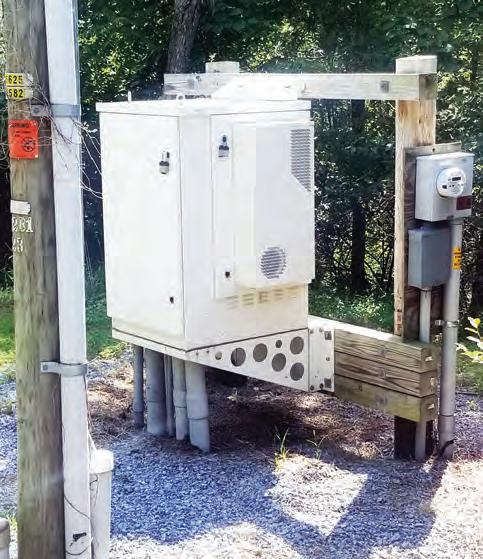
“Unfortunately, the project fell off the rails early on because of COVID and supply chain,” Greene stated.
“We had started the engineering in late 2020 and started ordering materials. Things that would normally take six to eight weeks pre-COVID suddenly became six or eight months. We couldn’t get the materials, we could get the construction crews in, then once we got the crews in, we didn’t have any MSTs or handholes. A project that should
have been finished by the third quarter of 2021 didn’t get finished until the second quarter of 2022.”
Now that the first part of PTC’s fiber network is completed, the telco is cutting customers over to all-fiber service. “We’re passing about 700 customers in the initial phase,” Greene said. “Will we get all 700? No, there will be people who stay with Comcast, but we’re getting a lot of Comcast customers jumping back across the fence because now we offer a better product.”
PTC was able to leverage the existing backbone fiber, XGS-PON, and Adtran’s Total Access 5004 chassis to provision GPON services for its phase one build and is seeking USDA ReConnect grants and loans to get fiber to most of the remaining 300. “Once we finish the second phase of this fiber build, we will have 90 to 95% of all the customers covered with fiber to the home,” Greene stated. “It’ll take us a couple of years to get that built. What do we do then? There are a lot of areas around PTC that, even with RDOF and all these other plans, I don’t think anybody is really interested in building because it’s too far off the beaten path. We might have some opportunities in the future, we’ll have to wait and see.”
Eastern Shore of Virginia Broadband Agency
The Wireless Act and Water Crossings
Quick Facts
• Joint Public Authority of Accomack County and Northampton County, Virginia
• Headquarters location: Exmore, Virginia
• First residential fiber: 2017
• Homes passed as of interview: 16,000
• Customers as of interview: 2,300 FTTH, 110 commercial
• Who we spoke to: Robert Bridgham, Executive Director, ESVBA
• Unique points: Virginia Wireless Act, middle mile and last mile carrier
The Eastern Shore of Virginia Broadband Agency’s first distinctive act was coming into existence. “We were created under the Virginia Wireless Service Authorities Act. The way the code is written, we’re classified as a wireless authority,” said Bridgham. “We exist as a standalone public agency that is not a sub-entity of either Accomack County or Northampton County, Va., the counties we serve.”
30 Fiber Forward • Q3
NLBC Fiber Fed Remote Cabinet deployed as part of FTTH expansion. Source: NLBC.
ESVBA is a Fiber Broadband Association Certified All Fiber Network Provider. Source: ESVBA.









ESVBA started in 2010 by building and operating an open access middle mile network and offering business services. Among the service providers using the open access network are Lumen Technologies and Windstream Communications. It received permission to deploy FTTH services to Virginia residents in 2017.
Its middle mile open access network runs roughly north to south from the Maryland/Virginia border along the Eastern Shore—a region on the eastern side of the Chesapeake Bay. The network follows Route 175 and 13 down to the Chesapeake Bay Bridge Tunnel and then under the bay. “We’re almost an island,” said Bridgham. “We actually were able to get fiber built across the Chesapeake Bay Bridge Tunnel from the Eastern Shore into Virginia Beach and connect to two carriers in Virginia Beach and then out to points west and south.”
ESVBA’s encounters with water obstacles didn’t stop with the Bay Bridge tunnel but did put it into limited wireless operations. “Tangier Island [Va.] is sitting 10 miles off the coast in the middle of the Chesapeake Bay and there are 700 people on it who deserve service as much as anybody in the country,” said Bridgham. “One of the endeavors in the build out was to provide broadband coverage to the 19 incorporated towns on the Eastern Shore. We were not going to leave Tanger out. We ran multiple licensed spectrum microwave links out to the island -- I don’t love microwave and I don’t love wireless, but it was cheaper than spending four and a half million dollars on a cable across the Chesapeake Bay.”
While Tanger’s middle mile is microwave, its residents have fiber connectivity for the last mile. “We put bucket trucks on barges, floated them out, and put fiber on the island,” Bridgham said. “Those folks have been very pleased with the fact that they are moving into the 21st century.”
Several federal government organizations and cellular carriers are on ESVBA’s fiber but Bridgham can’t directly claim them as such since they are a Type 2 provider, leasing capacity to other carriers. One potential future customer for ESVBA is the new Rocket Lab rocket factory being built next to NASA’s Wallops Flight Facility. “We’ve got fiber in the walls at Wallops Research Park, literally at their doorstep,” Bridgham said. “As soon as they want something, we can facilitate it.”
ESVBA plans to add an additional 11,000 homes passed throughout its service area using Virginia state funding, including communities around the very north end of the Eastern Shore near Wallops. “They’ve desperately needed broadband for decades and they just couldn’t get the agreements or funding,” said Bridgham. “It’s been a litany of challenges and we’ve got the easements in place along with the funding.”
MIDDLE AMERICA
Craighead Electric Cooperative / Empower Broadband
Empowering people
Quick Facts
• Electric cooperative subsidiary
• Headquarters location: Jonesboro, Arkansas
• First residential fiber: 2018
• Homes passed as of interview: 28,000
• Customers as of interview: 12,600
• Who we spoke to: Alysha Bowers, Chief Operating Officer, Empower Broadband
• Unique points: Community engagement through education, backfilling towns
Empower Broadband, the fiber broadband subsidiary of Craighead Electric Cooperative in Northeast Arkansas, prides itself on the relationship it has with its members.
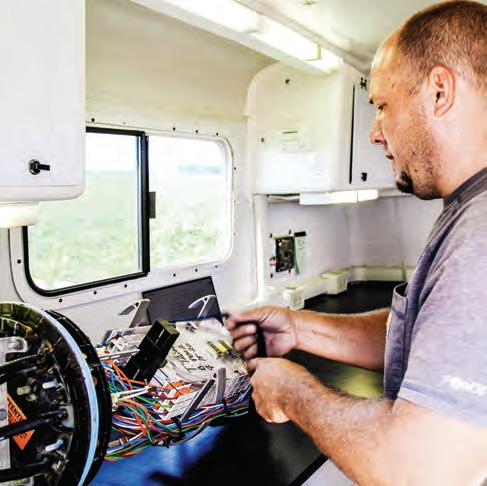
“Everybody trusts and knows the name of Craighead Electric, it’s been around for 85 years,” Bowers said. “That trust is built on that member-first mentality that we offer on the electric side and carries over to the internet side which traditionally people don’t trust. By looking at NPS score among the ISP industry, it’s easy to see that most operators aren’t exactly known for their customer service. Focusing on the ‘customer first’ mentality has helped us earn trust in our communities.” Bowers said.
Empower typically has at least two commercial competitors in any given area but having an all-fiber network and an emphasis on quality service provides a substantial advantage over cable and other offerings. Empower
32 Fiber Forward • Q3
Empower field tech makes repairs inside the mobile unit. Source: Empower Broadband.
has also gone out to assist people in digital literacy and applying for federal broadband programs, such as the Federal Communications Commission’s Affordable Connectivity Program (ACP).
“The ACP process can be very overwhelming for someone who lives out in rural Arkansas that’s never had broadband before,” said Bowers. “We’ve hosted what we call the “empower “ this year. We hosted 5 sign-up events in areas that house some of our lower income families. We went into libraries and community centers to help our customers understand how we work, learn more about the ACP program, and ultimately apply if they qualified. That community engagement is not something that customers are used to with our competitors.”
Empower is always going a step further, said Bowers, be it providing free internet to the local library and a new school safety call center. Its efforts have been noted by towns in the area not served by the electric co-op but wanting fiberquality broadband. Empower is working with local community leaders to help them understand the process required to enable the company to offer services in their areas.
“Our primary project was to include the Craighead Electric co-op membership,” Bowers said. “Our territory on the electric side would skirt around a city – and I use city loosely, because some of these places have 2,000 people who live there – and they have a different power company. You surround a town with a fiber network, it’s the brand-new shiny thing, everybody starts talking and they go to the city council meetings and say ‘What about us? We’re left out to dry.’ We’ve collected feedback through our website for around two and a half years and we’ve told people to talk to the mayor and their city officials about partnering with Empower. We’ve explored public-private partnerships, bond opportunities with big cities. A few areas were so adamant that we started to track potential take rates and decided we’re going to move forward without having either one of those types of agreements in place simply because the want AND need are there.”
Over the next twelve months of operation, Empower expects to add around 7,000 “off-net” homes outside of its core electric service area through a combination of its own, local, and federal funds.
Business, and Economic Development, CREC
• Unique points: Rapid growth
While parent–company CREC has been providing power to seven rural counties in Oklahoma for over 80 years, subsidiary Centranet is new to the fiber broadband world. Formed in 2020 and connecting its first subscriber in July 2021, it has grown at a rapid pace, quickly adding 3,000 subscribers with the expectation to pass up to 20,000 or more homes within the next three years, depending on how many electric co-op off-service areas Centranet goes into.
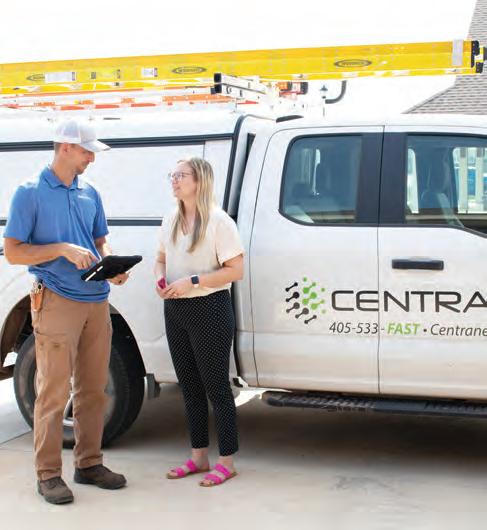
“We may increase that 20,000 to a bigger number,” said Gupta. “The off-system builds are dependent on how much federal funding is required to build those off-system areas. Most of our funding comes in the form of loans. We have applied for served different grants with NTIA and through the state of Oklahoma for ARPA money.”
Central
Rural Electric Cooperative
(CREC) / Centranet Mature Co-op, New to Fiber
Quick Facts
• Electric cooperative subsidiary
• Headquarters location: Stillwater, Oklahoma
• First residential fiber: 2021
• Homes passed as of interview: 8,000/40%
• Customers as of interview: Broadband 3,000
• Who we spoke to: Sachin Gupta, Director of Government,
Gupta said Centranet hasn’t felt the supply chain challenges that others have to date. “We’re tied with Calix for our customer premise equipment, and they have been a very good partner for us,” he said. “We have yet to experience any schedule delay related to equipment deliveries.”
The new fiber network has enabled Centranet’s business customers to better run their operations. “They were not able to do so in the past because they didn’t have internet,” Gupta said. “They couldn’t run their credit card machines and do a lot of things that they are able to do now.”
Centranet is coming in a bit later in the market to provide
(cont. on page 55)
33 Fiber Forward • fiberbroadband.org
Centranet team meets with new fiber customer. Source: Centranet.
Creating crucial connections for your growing network.



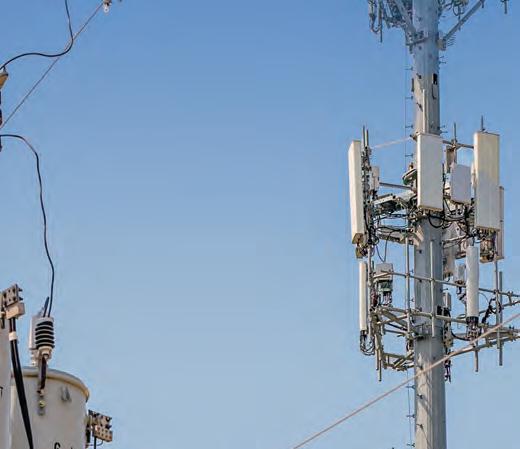
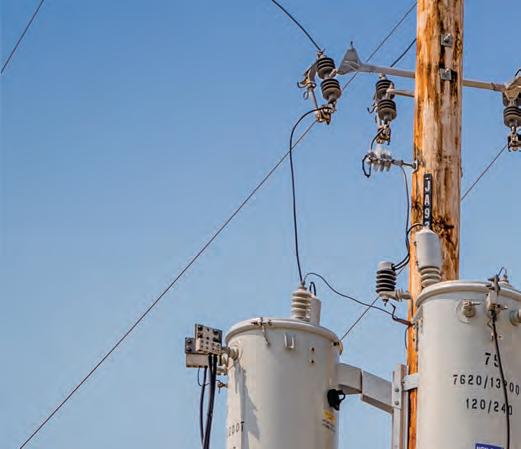





There are more avenues than ever to fund and expand broadband networks. Understanding the evolving regulatory environment, and assessing the necessary upgrades for aging infrastructure amid increasing demand, have become top priorities. Learn how we can collaborate with you as a trusted partner to deliver your vital fiber infrastructure initiatives at burnsmcd.com/Fiber22 .

O ces Worldwide
Public Safety’s Digital Transformation
By Doug Mohney
With little fanfare, public safety is going through a digital transformation enabled by fiber. It’s providing the foundation for the United States’ nationwide public safety broadband network and fueling the use of video and multimedia applications throughout the field, changing everything from how forest fires are being fought to the way 911 calls will be handled.
“Fiber plays a huge role in public safety communications,” said Ryan Burchnell, AT&T’s Director of FirstNet Market Strategy & Development. “A robust fiber network is necessary regardless of the last mile technology. For FirstNet, it’s an integral part of the core network and all of the functions of how the data information and calls travel from cell towers into the core network. We’re seeing massive growth in both commercial and dedicated FirstNet services.”
FirstNet is a unique public-private partnership to field and operate a dedicated public safety cellular network for first responder communications. Congress created the First Responder Network Authority (FirstNet Authority) in 2012, allocating 20 Megahertz of spectrum and $7 billion in resources to get the job done. In 2017, AT&T won the 25-year contract to be the commercial partner in building, operating, and maintaining the network.
Built using interoperability lessons learned from 9/11, FirstNet is an always-on communications platform with a physically separate network core fully dedicated to public safety. It provides priority and preemption to voice and data services for public safety communications as well as dedicated radio and spectrum capacity to first responders when needed.
The design of the network enables first responders to use dedicated capacity on FirstNet and supplement it with additional bandwidth from commercial spectrum as needed.
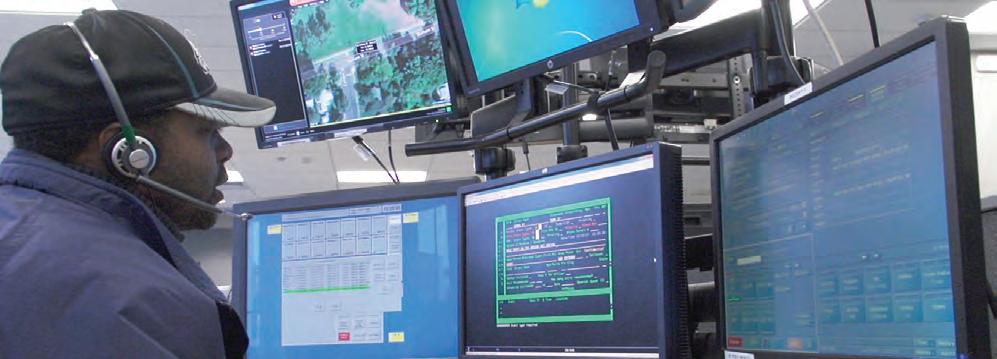
Accessing the network requires a specialized SIM card and an off-the-shelf cellular modem chip capable of accessing both commercial and dedicated FirstNet frequencies. Today, FirstNet provides over 3 million connections to devices ranging from unmodified cell phones from Apple and Samsung to specialized hardware including body cameras, alarm systems, routers, and commercial drones. AT&T added 5G to the core network which now supports over 19,500 public safety agencies and organizations, providing a growth path to more capacity as the first responder community embraces bandwidth-rich services, just as regular consumers are doing.
“When you get into the network for public safety agencies, bandwidth requirements are much higher than they used to be because of the use of things like video and situational awareness tools,” Burchnell said. “Video obviously is a big deal, especially in the last couple of years with the proliferation of video for law enforcement. You are also starting to see emergency medical services and telemedicine [applications].”
Even police roll call and other TV show clichés are getting a high-tech upgrade. “A lot of law enforcement agencies are now going to virtual roll call,” Burchnell said. “They used to come to the office before they started their shift and they sat in a room while somebody stood at the front and gave a briefing. Now it’s happening online via video chat. You’re
35 Fiber Forward • fiberbroadband.org
Public safety services are relying on fiber more than ever. Source: AT&T.
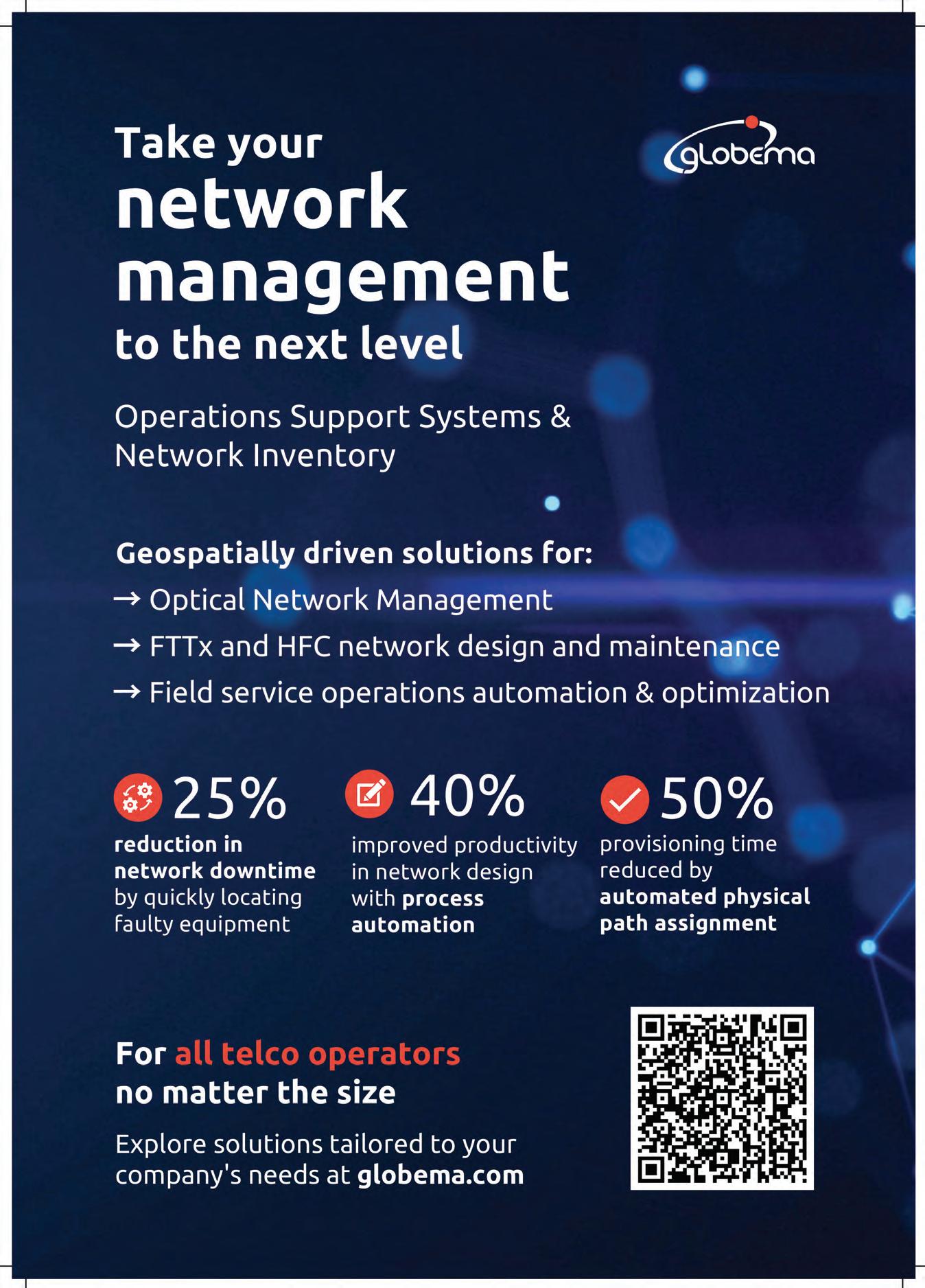
seeing a proliferation of computer-aided dispatch replacing radio-based systems for mobile units and the benefit we are seeing is a lot more coordination.”
The availability of fiber and more broadband is also changing the way 911 calls are being conducted. “Eighty percent of the calls come from mobile devices now,” Burchnell said. “But it’s still just a call. There are some comm centers that can receive a text message, but not most of them. When we get into next-generation 911, fiber on both sides is going to play a huge difference. It’s all multimedia coming in, video, text, not necessarily calling in from a [landline] phone. Fiber for that piece is essential with people becoming 911 reporters, not 911 callers.”

In the NextGen 911 world, fiber is the essential link moving data between the community, public safety call centers, and first responders with the call center being the central hub. First responders will be able to better understand what’s happening in the field before they arrive on-site.

How much more will fiber change first responder communications? It is opening new avenues with limitless possibilities, according to many.
“It’s up to the imagination of both the first responders and the application providers,” said Red Grasso, Director of the First Responder Emerging Technologies (FirstTech) program for North Carolina. “FirstNet has been the catalyst to do something purpose built for first responders. Fiber really brings the ability to scale up your bandwidth very easily, so you move to mere software changes rather than having to add additional hardware or equipment to support new features. All the applications now being supported on FirstNet provide a new market to app developers. Some of the virtualized technologies, such as virtual roll call, have not been possible in the past either because of lower bandwidth or unreliability.”
However, fiber is not only being used in the core network but being brought forward to the front lines in unique ways. Douglas Fast Net (DFN), a service provider headquartered
in Roseburg, Oregon, has deployed fiber optic cable to four locations in the area where the U.S. Forest Service sets up firefighting camps when needed.
“It’s a bandwidth need,” said Todd Way, CEO of DFN. “A T-1 isn’t going to cover it anymore. The Forest Service is doing a lot of flyovers capturing imagery. How did the fire grow over night? Which direction is it going, what percentage is contained? There’s a lot of data that’s disseminated to all the teams and crews out there. We play the mission critical part of bringing them the data they need.”
DFN-owned fiber has been brought to several open field locations in Oregon where the U.S. Forest Service sets up firefighting camps. When needed for use, trailers housing command posts, food kitchens, and showers will be trucked to the site with tents set up for firefighters. A DFN technician connects and lights the fiber, providing the onsite camp with gigabit-class connectivity for the command center and Wi-Fi for the firefighters in residence. Once the fire is put out, the process is reversed while the dark fiber remains in place ready for next season.
Due to the geography of Southern Oregon, fiber may be deployed underground or on poles. Underground is preferable since it avoids tree damage and offers some protection against fire, but most areas are only economically accessible using aerial deployments. Both methods have their challenges.
“The ground is hard, the federal permitting challenges are huge,” Way said. “At $60 to $70 a foot for rock drilling, it’s just not feasible. Being on poles means being exposed in the air and to all the elements with trees falling and eventually burning, but it might be the only way to bring fiber in.”
Even underground fiber doesn’t offer full protection against potential disaster disruptions. “We had a fire in 2019 that burned up a ton of our fiber, including stuff in the ground that melted from stumps and roots catching on fire,” said Way. “That was unexpected.”
37 Fiber Forward • fiberbroadband.org
Today’s public safety services require more reliable bandwidth than ever, so fiber-based broadband service is essential. Source: AT&T.
Fiber connectivity will revolutionize the way emergency services can communicate over multiple mediums. Source: AT&T.
The Smart Grid Evolves to Version 2.0
By Doug Mohney
Utilities have been incorporating fiber for decades into their operations, the infrastructure providing secure communications transport, gigabit-class speeds, immunity to interference from electromagnetic noise – especially handy around transformers and power lines – and the ability to be easily upgraded when needed.
For Chattanooga, Tennessee-based power utility EBP, a smart grid installed in 2010 in conjunction with its fiber broadband network has delivered hundreds of millions of dollars in benefits during its initial years of operation, according to a 2020 study by Professor Bento J. Lobo at The University of Tennessee at Chattanooga. The study showed that the combined smart grid and fiber deployment provided increased reliability, resilience, and redundancy into electric power delivery for the area.
The study, “2020: Ten Years of Fiber Optic & Smart Grid Infrastructure in Hamilton County, TN,” says the largest financial benefit delivered by EBP’s smart grid has been outage reduction, with Lobo putting the value of fewer outages at around $26.4 million per year to customers.
When tornados and heavy storms rolled through EBP territory in April 2020, the smart grid was able to automatically protect around 44,000 customers from losing power for hours or perhaps days. It also allowed the utility to immediately identify where around 62,000 of its customers had lost power, enabling it to restore service to 20,000 more households within 24 hours.
Leveraging the ability to use automated switching and demand-side management programs to shave peak load power, EBP has reduced power usage by 1,865 megawatts over seven years, saving $20 million in power that would have had to been otherwise generated. The use of automated meter reading has saved the utility over $9.4 million dollars over the same period, with another $4.6 million associated with remote service disconnect/ reconnect and planned switching events.
More Smart Grid Data, More Insight
At Fiber Connect 2022 in Nashville, utility broadband operators discussed how their smart grids were delivering better data, enabling them to control their networks like
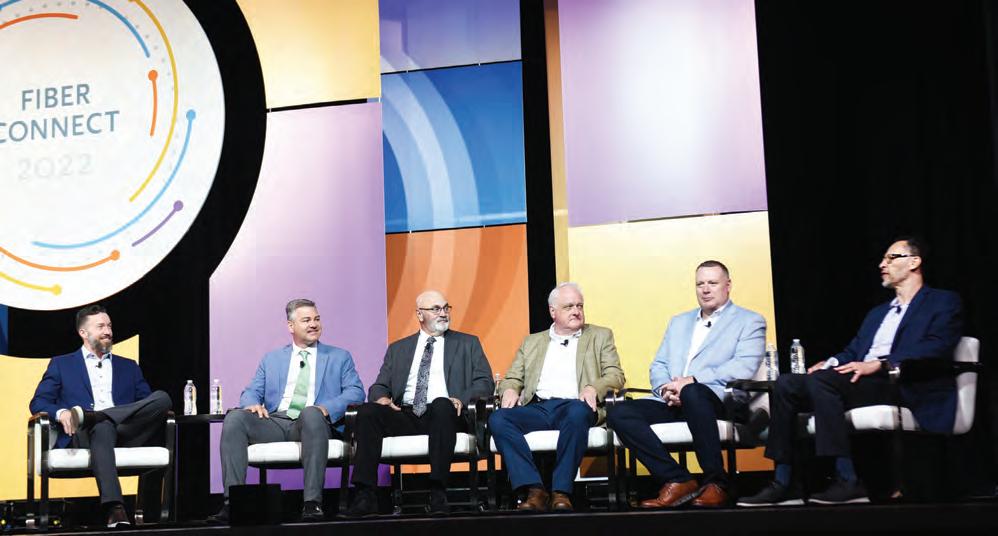
38 Fiber Forward • Q3
The Fiber Connect 2022 keynote panel focused on utilities and smart grid featured Craighead Electric Cooperative Corporation’s Jeremiah Sloan, Seven States Power Corporation’s Lance Irwin, BrightRidge’s Jeffrey R. Dykes, Cullman Electric Cooperative’s Tim Culpepper, OzarksGo’s Steve Bandy, and was moderated by Telecompetitor’s Bernie Arnason. Source: FBA.
never before by tapping into the insights the information provides and better manage renewable energy and storage systems.
“One of the things we’re really looking at for the future, things that we weren’t looking at three or four years ago, would be smart analytics, AI, forecasting,” said Steve Bandy, General Manager of Ozarks Electric Cooperative of Fayetteville, Arkansas. “We pulled out information, went through some charts and graphs, over 7.2 million lines of data. And that was just for one hour.” Bandy said the wealth of data would enable utilities to be able to tailor rates for services like EV charging while smart meters would provide more data to help members and the nonprofit co-op save money.
“As a cooperative, we have to outlay costs, because we are a non-profit,” said Tim Culpepper, CEO of Cullman Electric Cooperative of Coleman, Alabama. “The smart grid gives us the information to be able to allocate those costs when it should be, to be fairer to our members so that they are actually bearing the cost of what it tastes to supply [power].”
“The ability for what we can do on a smart grid to control the grid and keep their pricing now, our goal is to not have to raise rates,” Bandy said. “How do you do that? We’re dealing right now with potential rolling blackouts back home, but it looks like we’re not going to have to do that. You can use your smart grid to be able to help your member base and not have to do that.”
Several providers are using smart grids to manage the twin towers of renewable energy and storage. Many businesses want to use renewables to reduce their carbon footprint, but solar and wind generation are variable rate producers, dependent upon weather conditions unlike traditional power plants. Grid-scale storage enables utilities to bank and buffer power as needed, storing power from renewable and traditional sources when there’s excess production and when it’s cheapest and using it during peak times to respond to demand. Storing cheaper power during off-peak times enables utilities to keep electric rates lower rather than having to buy or produce energy at peak times and higher rates.
“We have a partnership with one of our members who installed a battery energy storage system and solar generation, it’s a three-megawatt facility,” said Jeremiah Sloan, CEO of Craighead Electric Cooperative in Jonesboro, Arkansas. “We’re able to change the way that our electric grid flows at peak times on the network in order to dispatch those batteries to save ourselves on wholesale power costs. We would never be able to do that with our copper network, we needed that high speed, low latency fiber connection to dispatch that battery system when it was most needed on our network to literally open and close different circuits or to have the load available for the battery to offset. That one is particularly cool for us.”
The Power of Numbers
First generation Smart Grid applications centered around the individual utility and its resources, with renewables, grid storage, and electric vehicle (EV) charging rolling into the picture as they became more prevalent. But what if you could combine that functionality across hundreds of local power cooperatives and municipalities, unlocking resources in a new way?
Seven States Power Corporation is headed in that direction as it uses its middle mile network to enable power utilities to deliver fiber to the home and build their own smart grids. As a non-profit generation and transmission cooperative, it works with the 153 local cooperatives across seven states of the Tennessee Valley Authority (TVA)—a corporate agency of the U.S. that provides electricity for local power distributors and business customers. Seven States is the process of leveraging its existing 1,500 miles of fiber and adding another 2,200 miles of fiber to interconnect all of its members. This also enables them to offer broadband using Seven States for middle mile connectivity as they deploy their individual last mile networks along with a bit more by leveraging extended Smart Grid connectivity.
“We’ll be able to aggregate distributed generation assets together and deliver that back to TVA as if it were a virtual power plant,” said Clint Wilson, Seven States Senior Vice President of Engineering and Market Innovation. “That could be solar, it could be battery storage, it could even be EV chargers.”
The benefits of interconnecting smart grids will go far beyond power generation aggregation. “We’re adding some redundancy to their network,” Lance Irwin, Vice President of Partnerships and Project development for Seven States. “And we’re adding capability for doing some off-site disaster recovery, and even mutual aid for call centers and dispatch and system operations, not just sending my linemen over, but I can help you take calls and dispatch crews now that our networks are connected across the valley together.”
EV charges are smart devices that need a path to communicate. Connecting charges across the TVA provides significant value to Seven States and its associated members in being able to manage the power load at any given moment and communications needs to be secure as well, a cybersecurity service is on the horizon for Seven States.
“If we’re going to connect all these edge devices, it has to be done in a secure way,” Irwin said. “It’s an area we’re really focused on. Yes, we deal with the glass and the electronics, but those messages need to be secure, those networks need to be secure and monitored because those threats are constantly changing. We’re trying to help mitigate those problems.”
39 Fiber Forward • fiberbroadband.org
Fiber Connect 2022 – FBA Awards Member Accomplishments
By Doug Mohney
At Fiber Connect 2022 in Nashville, the Fiber Broadband Association recognized the individuals and organizations who have contributed to the betterment of communities around the country and the industry at large.
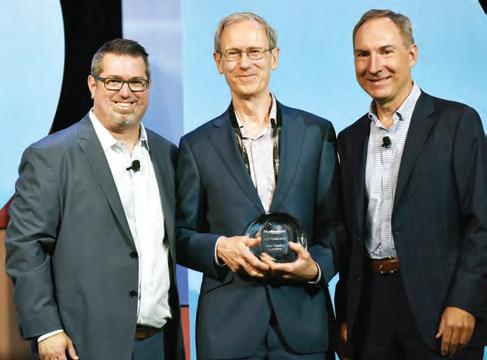
“The Fiber Broadband Association is proud to recognize the people, communities, and companies going above and beyond to build the nation’s next generation of broadband infrastructure,” said Gary Bolton, President and CEO at Fiber Broadband Association. “Congratulations to all of this year’s award winners. They recognize the power and necessity of high-speed, low-latency connectivity and their efforts are advancing the delivery of fiber broadband and unlocking unlimited possibilities across North America.”
Chairman’s Award –Veronica Bloodworth, Frontier
Veronica Bloodworth, Chief Network Officer at Frontier, received the 2022 Chairman’s Award for her longstanding and ongoing contribution to promote and accelerate Fiberto-the-Home (FTTH).
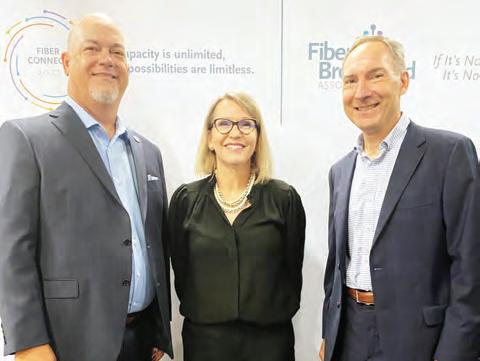
“The Fiber Broadband Association is proud to recognize Veronica for her efforts advancing fiber connectivity forward and creating a better broadband future for communities and businesses across North America,” said Kevin Morgan, Chair of the Board at Fiber Broadband Association. “Her many years of leadership at Frontier and
AT&T have delivered high-speed broadband to tens of millions of homes.”
As Chief Network Officer at Frontier, Bloodworth oversees all of the company’s network operations, including leading Frontier’s fiber-first accelerated buildout that is expected to reach 10 million total locations by the end of 2025. Prior to that, she was with AT&T for 23 years, rising to the position of Senior Vice President of Construction and Engineering. Under her leadership, AT&T deployed fiber to over 14 million customers.
“So much has changed since I first started working in the industry, when dial-up modems and pagers were the thing,” said Bloodworth. “Today, Fiber-to-the-Home deployments are core to driving everything from remote work, to gaming, and watching sporting events in 4K. We have a real opportunity to close the digital divide in the next five years and I’m proud to be a part of the Fiber Broadband Association’s mission to connect people for generations to come.”
Gene Scott Education Award –Greenlight Community Broadband, Wilson, N.C.
The inaugural Gene Scott Education Award was presented to Greenlight Community Broadband of Wilson, N.C. The award recognizes a person, community, or institution that
40 Fiber Forward • Q3
Corning’s Stan Fendley receives the FBA’s Photon Award at Fiber Connect 2022. Source: FBA.
Frontier’s Veronica Bloodworth received the 2022 Chairman’s Award at Fiber Connect 2022. Source: FBA.
has significantly impacted the advancement of education in the fiber industry.
Gene Scott was a long-time community broadband advocate and a friend of the fiber broadband industry. Gene passed away in February 2022. He served as Chairman of the Fiber Broadband Association’s Education Subcommittee and was instrumental in the development of the Association’s Optical Telecom Installation Certification Path (OpTIC Path™) training program formally launched this year.
Greenlight Community Broadband is a communityowned, FTTH provider in Wilson, N.C. Since its founding, the service provider’s priority has been to provide comprehensive broadband connections to support local economic health, enhance citizens’ lives, and improve the delivery of city services.
“Greenlight fostered and supported Gene’s ongoing efforts to build workforce training programs, working with Wilson Community College in North Carolina to create an affordable fiber technician training course,” said Mark Boxer, Technical Manager, Solutions and Applications Engineering at OFS, and Fiber Broadband Association Board Member.
“This effort charted the way for the Fiber Broadband Association’s OpTIC Path certification course to launch this year—a program that will provide specially-trained fiber optic technicians to the industry and help service providers meet the historic broadband demands created by billions of dollars in federal funding.”
“Greenlight and the city of Wilson were very special to Gene. It’s our responsibility and honor to carry on his work in our community and in workforce training for the growing needs of the fiber industry,” said Will Aycock, General Manager at Greenlight Community Broadband. “We concluded the pilot OpTIC Path course at Wilson Community College with great success and enthusiasm from the trainees. We look forward to continuing this course here and helping other communities replicate its success.”
Photon Award – Stan Fendley, Corning
The Association presented its Photon Award to Stan Fendley, Corning’s Director of Legislative and Regulatory Policy. The award honors a Fiber Broadband Association member who, through volunteer contribution, has demonstrated a high level of dedication to the organization and has contributed greatly to the industry.
Fendley has served as the director of legislative and regulatory policy for Corning for the past 22 years. During this time, he has been dedicated and instrumental in the founding and development of the Fiber Broadband Association and was first recognized with the Star Award in 2002. Since then, Stan has been a strategic leader in the Fiber Broadband Association, serving on the front line of the Association’s advocacy and public policy initiatives and working with Capitol Hill, key federal agencies, and the White House. He also helped create the Fiber Optic
Sensing Association (FOSA) in 2017. His work continues to help close the digital divide and deliver future-proof broadband to every household in North America.
2022 Star Award – Sunbridge community in Central Florida
The Fiber Broadband Association’s Star Award recognizes a person, community, or company that has gone above and beyond what is expected in the advancement of FTTH.
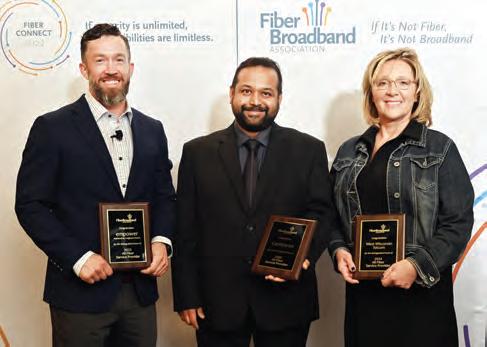
Sunbridge is a 24,000-acre master-planned community in Central Florida built by Tavistock Development Company. When traditional incumbent service providers did not offer high-speed broadband options in the Central Florida region surrounding Sunbridge community, Tavistock Development Company decided to provide 10G symmetrical FTTH services all on its own. Tavistock will provide up to 10 Gbps symmetrical FTTH services to an anticipated 10,000 residents over the next 10 years to support the large-scale development plans for residents and businesses and their increased demand for OTT streaming, telehealth, remote education, and work-from-home scenarios.
Certified All Fiber Service Providers
In addition to the Fiber Broadband Association’s annual awards, FBA recognized the latest group of service providers to obtain All Fiber Certification for ensuring their customers can access the fastest, most reliable broadband connectivity available. The All Fiber Certification is available to Fiber Broadband Association members who demonstrate a high-level of strategic commitment to all fiber deployments by ensuring 90% or more of their networks rely on fiber optic infrastructure.
All Fiber Certification service providers recognized in Nashville included Centranet (Okla.); empower (Ark.), MAW Communications (Pa.), Fibersonic (Mass.), VNET Fiber (Pa.) and 24-7 West Wisconsin Telcom (Wis.).
41 Fiber Forward • fiberbroadband.org
FBA members empower, Centranet, and West Wisconsin Telcom were recognized at Fiber Connect 2022 for achieving All Fiber Certification. Source: FBA.
Broadband Infrastructure Playbook Update – July 2022
By Doug Mohney
Released in March this year, the Broadband Infrastructure Playbook has been updated to reflect the NTIA Broadband, Equity, Access, and Deployment (BEAD) Program Notice of Funding Opportunity (NOFO) information released in May.

“The Fiber Broadband Association anticipated and planned for changes to the Playbook based upon the evolution and clarification of guidance and policy from NTIA,” said Gary Bolton, President and CEO at the Fiber Broadband Association. “The July 2022 update provides states with the latest information as they embark on closing the digital divide and building high-speed, future-proof fiber infrastructure that will last for generations. As always, the FBA stands ready to assist to ensure each state and every
home can leverage this once-in-a-generation opportunity to bring everyone and every community forward.”
The Playbook was created in partnership with NTCA–The Rural Broadband Association and developed by Cartesian, a specialist consulting firm focused on the global telecommunications, media, and technology industries with updates discussed in a July 12, 2022, webinar.
“We built on guidance from the NTIA which was released in the Notice of Funding Opportunity that came out in May,” said Michael Dargue, Vice President of Cartesian. “We’ve conducted a detailed review of that NOFO and added additional detail on the content of the BEAD funding
42 Fiber Forward • Q3
application and also concepts of fiber being the priority broadband project, the project selection criteria, and detail on the obligations for the states and the sub-grantees.”
“BEAD is an incredible opportunity and everybody should be thinking about ways to seize it,” commented Tom Cohen, FBA Counsel and Partner, Kelley Drye & Warren LLP. “That said, we are still operating with a lot of uncertainty even after the Notice of Funding Opportunity. NTIA tossed in a lot of issues with the 100-page NOFO. Some of them were required by the statute, some of them were pushed by the administration. Everybody is saying, ‘What does that mean? How far will NTIA go? What if we push back?’”
Cohen said while there is uncertainty, participants in BEAD can do things now to move forward. “This is not a time to stand still,” he advised. “You really need to think about how you play seriously.” Part of the process is gathering evidence about broadband needs and solutions to understand the “boundaries” between the NTIA, the administration and state and local governments.
“Certain things are in the [BEAD] statute,” Cohen continued. “Other things are on the administration’s wish list. In addition, states differ on what they need and their priorities. Understand those boundaries. In addition, always be persistent and patient. This is a process of converging, and we’re going to take some time to get there. Finally, you should work both top down from NTIA and bottom up from local areas to the state as we’re going to be in a period of uncertainty for a while.”
Michael Romano, Senior Vice President of Industry Affairs & Business Development, NTCA–The Rural Broadband Association joined with Cohen’s comments in an optimistic tone. “I think never has a 100-page document said so much and yet left so much unanswered,” he said. “I think that’s a feature, not a bug. I think in large part it was done because, as Tom said, there are boundaries that need to be set, statutory provisions that needed to be framed out, but also recognizing the need for NTIA to work with other agencies to perhaps clarify some things.”
There are 10 to 15 material items that still need to be defined and are going to be critical to scoping out what the BEAD program really means, Romano stated, including the low-cost option, affordability requirements, some of the “Buy American, Build America” provisions, and the definitions of what is Extremely High Cost.
Romano advised reviewing state broadband maps for project scoping and identifying opportunities as one area worthy of examination while policy clarifications are made at the federal and local level. “Take a look at the existing FCC maps even though FCC’s map to come will be the determining factor for what’s eligible and what’s not,” he said. “Use other pieces of information that are available now to scope out what might be eligible, think about what
kind of projects might go there, start thinking about the economics of them in anticipation of wanting to hit the ground running when the application windows open at the state level… there’s no time to waste.”
Much of the burden in BEAD going forward will be on the states, according to Joanne Hovis, FBA Board Member and President, CTC Technology & Energy. “The task before the states is absolutely monumental,” she said. “They not only have to figure out how to make a robust but finite number of dollars go as far as possible to solve the entirety of the broadband access problem, but they also have to satisfy the widest possible range of stakeholders and they will undertake massive amounts of stakeholder engagement based on the very prescriptive set of requirements that NTIA has given them. They will also be subject to lots of ideas and opinions about how that money should be used and they have very challenging statutory and NOFO goals to meet as part of this planning cycle.”
Hovis recommended “enormous patience” and recognized that states will be competing against each other for supplemental funding along with finite labor and materials due to a probable mismatch of demand and supply.
Working with state offices and building alliances with local communities and organizations was underlined by Ariane Schaffer, Government Affairs & Public Policy, Google Fiber, and Co-Chair, FBA Public Policy Committee and Jordan Gross, Manager, Federal Government Affairs, Corning.
“One thing to be doing in these next few months is really identifying your assets and your allies and making sure that your state broadband office is aware of what you want and how you envision your community moving forward,” Schaffer said. “Using the updated Playbook is a good start for discussions.”
“It’s all about engagement,” Gross said. “The Playbook is an incredible resource that’s been put together, but it’s a jumping off point to have these conversations with your state broadband offices and it’s also a great tool for local communities, as well. We need to make sure that we get as much mileage out of this Playbook as possible and we are bringing to them not just issues and concerns but also solutions and the opportunity to work together.”
Everyone recognized there’s more work to be done, but there is also a path forward for local and state leaders and community advocacy groups. “The [July] NOFO was in some ways the start of the beginning of the end or the end of the beginning,” said Romano at the conclusion of the discussion. “There’s a lot more to do here and I would encourage people to stay engaged at multiple levels in terms of their own projects and program formation.”
A copy of the updated Broadband Infrastructure Playbook can be downloaded at https://www.fiberbroadband.org/ page/playbook.
43 Fiber Forward • fiberbroadband.org
The Importance of Managing the In-Home Experience
 By Doug Mohney
By Doug Mohney
Once upon a time, the responsibility of broadband delivery for fiber providers stopped at the demarcation point where services were delivered into the home, typically from an Ethernet jack in the ONT. That position has steadily evolved as -- like it or not -- consumers have associated poor quality in-home experience with their broadband connection. Meanwhile, service providers are looking for ways to reduce churn and increase revenues, which has meant the in-home experience has become an unavoidable responsibility for them.
Managed Wi-Fi is “taking off” said Kristen Hanich, Director of Research at market research firm Parks Associates. “Managed Wi-Fi is delivering a lift of around $10 per month in revenue,” she stated. “We’re finding raising average revenue per user (ARPU) isn’t necessarily the main purpose of these and other services, but that they service multiple purposes. One is to help upsell customers from lower-tier plans to higher-tiered ones, making plans overall more sticky and the customer more likely to stay or raising customer satisfaction. There’s a huge lift in net promoter scores when customers subscribe to more of these services. We’re also seeing for some services, such as managed Wi-Fi, they’re helping to reduce calls to customer support, which is directly saving Internet service providers money.”
Service providers are experimenting with various business models to roll out managed Wi-Fi, Hanich said, some charging an additional monthly fee for the service and rolling in the cost of equipment in with the other CPE chargers, with others offering managed Wi-Fi to all of their customers to increasing overall satisfaction and reduce call center traffic.
Parks Associates is tracking around 20 different valueadded services in its regular broadband provider surveys, Hanich said, with pay TV still the “big one” and over-the-top (OTT) streaming services from partnering companies also ranking high. “Pay TV is an interesting story,” she said. “It’s not seen as a profit center and it hasn’t it been for a while, but more of a competitive factor. A lot of service providers are bundling it in with home internet and passing along the cost of the service to their customers. There are still customers who still want Pay TV and if you don’t have it, they’re going to go to one of your competitors. A lot of service providers are looking towards some of the new streaming TV solutions. Partnering with those companies can save money since they’re much less expensive.”
But one recent offering has cooled off. “Home security has declined quite a bit compared to where it used to be,” said Hanish. “There are not a lot of service providers bundling together internet with home security anymore. We’re seen a lot of independent players enter the market, companies that specialize in doing home security, so the 24/7 professional monitoring companies are pretty strong. We’re also seeing a lot of new DIY solutions enter the market, for example a lot of people are turning to the Ring cameras you can just buy from Amazon.”
Newer value-added services coming onto the market include gamer packages and health monitoring. “We’re seeing broadband providers beginning to offer ping reduction services to gamers,” Hanlich said. “This helps to optimize the route that gamer traffic goes from their home computer to all the way in the cloud, making sure that it is as short as possible. I’ve been hearing a lot about health
44 Fiber Forward • Q3
In-home experience requires smart home planning. Source: Zhu Difeng.
monitoring and fall detection, which are enabled by some of the new advances we’re seeing in Wi-Fi motion sensing technology. It works using the Wi-Fi in from the regular router in the home, off the shelf standard equipment, having it function like a radar system able to detect if someone is up and about. By applying AI and machine learning, it can figure out if something has gone wrong with a senior’s daily routine. If they’re fairly active and one day they haven’t moved from their bed in maybe 12 hours, they’ll notify a monitoring center that would reach out to the seniors themselves or family members or try to contact them directly and if appropriate contact emergency services.”
To support and improve the in-home experience, service providers aren’t standing still. “Internet service providers as a whole are investing in their networks to improve speed and performance as well as upgrade their customer premise equipment,” Hanlich said. “We’ve seen quite a few accelerate fiber rollouts and we’ve seen upgrades to HFC networks as well with more attempts to make services faster, more symmetrical.”
The improvements are also taking place with in-home solutions. “In terms of CPE, we’ve seen a lot of service providers beginning to roll out Wi-Fi 6 devices with mesh networking capabilities,” Hanlich said. “It’s something like 40% of router owners in the U.S. now have mesh, where is a dramatic increase from last year and a lot of this is being driven by service providers. A lot of apps now have managed Wi-Fi capabilities to see which devise are on the network and are able to shut them off independently. A lot of people really like that.”
Managing Wi-Fi – The Consumer Side

Many service providers are turning to Plume’s Software as a Service (SaaS) platform to provide a better in-home experience for customers with inclusive management and data tools for service providers to monitor for and fix problems. Using cloud-controlled, software-defined solutions, service providers can offer customers a self-installable Wi-Fi mesh solution that self-optimizes for the whole home using AI. Plume’s solution is deployed in more than 41 million locations and over 30 countries around the world.
“For consumers, Plume enables unique control and comfort in managing their home network,” said Jeff Gavlinski, Plume, Global Vice President of Telecom and Wireless Associations. “Our HomePass application contains valuable services. The first, Adapt, is a self-optimizing Wi Fi technology that provides complete in-home network visibility and helps consumers understand the health of their in-home network, devices connected, and where they are in the home. Using Adapt, their home Wi-Fi network is always adapting, utilizing artificial intelligence to customize their network, based of on the size of their home, the quality of the connections in and around their home, and device usage patterns.”
HomePass’ Control function provides consumers the ability
to create network access “conformity,” Gavlinski said, providing the ability to block unwanted websites and ads through a content manager, parental controls to set tools for access and usage times, guest network and password management. Guard uses an “enterprise grade” threat data base that’s updated in real time to detect IoT and other devices, providing intrusion detection, quarantine capabilities, and external threat blocking.
Sense, perhaps the most unique feature of HomePass, provides a combination of motion detection through Wi-Fi devices in the home and detection of unknown devices around the network. “Motion sensing uses known subscriber-owned devices which become sensors that can detect expected and unexpected movement throughout the home,” said Gavlinski. “Effectively, your iPhone or a Samsung phone becomes a motion detector along with the other Wi-Fi devices in the house. If there is movement within the house, I get updates on my phone to let me know where that movement occurs. If there’s a device that the network does not recognize, it alerts me to that. Consumers can track historical movement throughout the home within HomePath app itself.”
Managing Wi-Fi – The Service Provider Side
To deliver a managed Wi-Fi system to its customers, a service provider would typically buy Plume’s SuperPod hardware for installation into the home along with licensing the company’s OpenSync software for use by the service provider to monitor all customer in-home devices and Wi-Fi. Service providers get two software suites to improve subscriber management and enable data-driven network insights.
“Haystack is a subscriber experience management and data prediction and analytics platform,” said Gavlinski. “Highlighted features include Signal, an AI powered monitoring and resolution tool that alerts, predicts, and resolves in-ho me network issues. Signal can also predict future churn rates and net promoter scores by real by utilizing real time data analytics. Panorama includes real time
45 Fiber Forward • fiberbroadband.org
Plume Superpod enables robust work from home environment.
Source: Plume.
YOU DESERVE THIS RAISE.
Introducing the XRT by DewEze, now with 5500# lift capacity. The all-in-one versatile unit with take up and pay out capabilities. Simplify fleet maintenance and improve safety on the jobsite. Let’s start your next project together - call to schedule a demo!

network troubleshooting, graphical representation of deep network insights, KPI tracking, targeting customer growth and adoption, as well as marketing campaign effectiveness, device analytics and cybersecurity reports. And then the last feature is Frontline, a tool set of comprehensive tools and dashboard for network ops, the folks monitoring the network. It includes customer health checks and redemption for resolution, quality of experience for devices, expanded topology of connected devices with our time machine to go back in time and actually redraw events interruptions. All this all this full customer lifecycle management.”
HARVEST is Plume’s data-driven insights and campaign automation software program. Its features include Clarity, an analysis of customer trends, growth and churn results and then it also provides visibility into who is and who is not on your network, device trend analysis of application usage, market share and actual customer scoring. Generate creates reports for sales and marketing campaigns which feature user insights into adoption rates, brand affinities and purchasing power as well as a consumer profile manager for custom campaigns. Topping it all off is Crusade, an autonomous campaign tool that helps to increase revenue with integrated marketing materials.
Adding healthy utility

Managed Wi-Fi gives providers a way to lower churn and establish brand value by establishing a solid foundation of service within the home, Gavlinski said. It also provides a way to deliver additional value-added services in the future.

“Thrive will be a new service integrated into HomePass,” said Gavlinski. “It will help monitoring aging-in-place and features services such as digital wellbeing for screen time monitoring, personal health insights, and offers healthrelated IoT devices. In combination with Thrive, we’re going to be offering a new ring to monitor key health metrics and use AI-driven monitoring that will include fall detections, sleep trends, stress detection, blood oxygen trends, activity monitoring, and care group notification.”
Thrive’s care group notification can be something simple as sending alerts to family members or an appropriate health care provider, effectively extending the in-home experience to telehealth monitoring. “As we see more diagnostic healthcare and telehealth being offered in the home, I think you’re going to see a lot more from Plume in that area,” Gavlinski said. “We view Thrive as much needed and a timely innovation for our customers.”
The other innovation Gavlinski is looking forward to is Wi-Fi 7. “We’re going to need equitable distribution of the capacity coming into the outside of the home inside the home,” he said. “It doesn’t matter where you are or the application, the Wi-Fi network should have the same performance in all locations. Today, we can’t do that effectively, but I think with Wi-Fi 7, we should be able to. It’s going to be really important.”
46 Fiber Forward • Q3
not
XRT NOW AVAILABLE www.deweze.com sales@deweze.com (800) 835.1042
*Do
exceed GVWR
Getting Best Value Out of Fiber: The In-Home Experience Working Committee
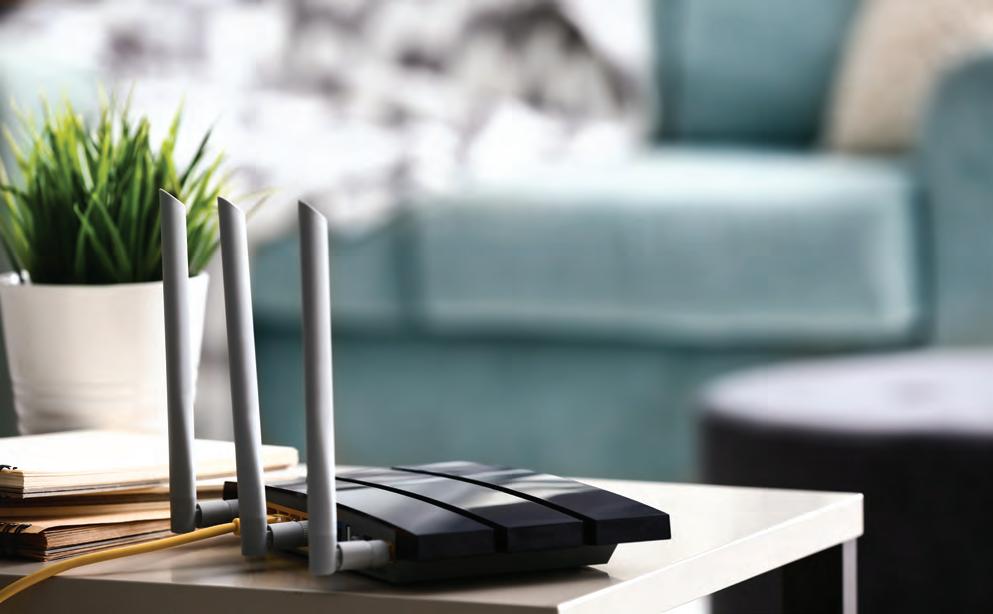 By Doug Mohney
By Doug Mohney
As fiber broadband moves into households across the country, with multigigabit speeds becoming the new normal, attention is shifting to best delivering those speeds beyond the optical network terminal and router. The Fiber Broadband Association’s In-Home Experience Working Committee examines the role that Wi-Fi will play as we close the digital divide and more consumers get Gigabit broadband to their homes. Participating members include 3E8 Broadband, Calix, Corning, IQ Fiber, Metronet, Nokia, OFS, OnTrac, and Shentel. The committee will be focusing on three strategic areas: 1) The influence of building and installation best practices, 2) Wi-Fi technology education, and 3) Methods to deliver a superior customer experience with applications.
“If customers only see their service as a simple connection to the internet, the fiber industry will find itself competing only on speed and price,” said Doug Blue, Chairman of the In-Home Experience Working Committee and responsible for business development for Nokia’s network infrastructure division. “It will be a race to the bottom with little room for
innovation and profit.” Service now extends well beyond the demarcation point and is measured by consumers’ ability to stay connected to the internet throughout their living space and beyond. “Managed Wi-Fi,” Blue said, “is a critical part of how a service provider can ensure a subscriber can get the most out of their connection.” The committee will most certainly focus on helping consumers see the benefits of managed Wi-Fi and aid operators with tools to help sell the service.
Adding value beyond the delivery of high-speed broadband service is paramount to the future success of service providers. “The Fiber Broadband Association has been laser-focused on delivering a multigigabit fiber solution to every home in the U.S., so everyone has access to fiber-based, high-speed, low-latency broadband,” Blue said. “When most vendors and companies look at an inhome experience, they often think of it in the context of good Wi-Fi so that every device can access able to provide broadband everywhere. That’s a part of it, and education will very much be a part of the committee’s focus. But we
47 Fiber Forward • fiberbroadband.org
Better broadband means more capacity available for whole home Wi-Fi systems. Source: Adobe Stock.
also all need to start thinking about how we as operators remain relevant in the future through service differentiation.”
Blue said there’s a wide range of things the group can look at, but we will have to be careful not to try to bite off more than we can chew. One area of focus will be material for consumers, the building/construction community, and service providers to help define best practices for optimizing Wi-Fi installations. For example, today’s builders of new homes and multi-dwelling units continue to place a service demarcation point either in a closet, a garage or in the basement of the building. Unfortunately, the industry hasn’t adapted to today’s broadband world and 21st Century Wi-Fi home coverage needs – this needs to change.
“One of the things the committee is considering as part of our future efforts is working with architecture firms to change existing design practices. Though this won’t be an easy undertaking, we would love to help influence future national or localized building codes to reflect better practices to optimize such an important utility.”
Looking at the merits of different technologies may also be a part of the In-Home Experience Committee effort. “We have several different Wi-Fi technologies that are coming in the next 12–24 months - Wi-Fi 6E and Wi-Fi 7”, said Blue. “These next-gen Wi-Fi technologies may provide adequate connectivity to the average home, but not every system/ solution is ideally suited for every deployment scenario. Not all Wi-Fi solutions are created equal.” He also cited as an example a current debate within the Wi-Fi community on implementing mesh networks with one camp supporting smaller devices that are dependent on cloud connectivity for optimization and band/device steering versus using more significant, more capable devices capable of optimizing the network locally as part of the need to provide continued education around Wi-Fi.
In competitive markets with multiple high-speed broadband options, there are three factors where customers will typically leave a service provider. Price is the most obvious, with customers switching from one provider to another to save $10 or more monthly. Reliability is another, with customers departing because of significant and numerous outages. However, as service providers master the first two, reducing churn through the ability to “provide
applications that customers will covet,” Blue said, The Committee believes that fostering an ecosystem of applications based on open and standards-based architectures will help operators retain customers via service differentiation. “We’ve been thinking about how we can normalize or provide methods or toolkits to create applications for those environments,” said Blue. “Maybe not having service providers or equipment providers create them but work with some strategic partners so our members could add applications onto their devices. For example, OpenWRT is a widely used operating system where applications - like a speed test and security/parental control solutions - can be provided to our members to leverage.”
Beyond carrier-grade, wi-fi connectivity, value, and value-added applications that can reside on a gateway to differentiate services, the home remains an ideal beachhead for further revenue opportunities. “Being able to simplify a smart home, for example, is another way to impact the customer experience. said Blue. “The true smart home is often a complicated home that can frustrate the savviest consumer. Are there ways we can leverage not only Wi-Fi within the home but also provide something of utility and value? Perhaps service providers can offer smart home “kits” to support smart lights, the garage door, water sensors under the sinks and toilets, sprinklers, and air quality monitoring beyond the basic alarm system experience. This is much further down the road, but it could be another element of the customer experience.”
Putting fiber more profoundly into the home isn’t part of an architect’s or builder’s playbook. “The incremental cost and complication for a builder to optimize the future placement of a Wi-Fi gateway are small because it requires conscious and deliberate changes to best practices,” said Blue. “It’s one more wire, one more piece of plastic, and one more outlet. For existing homes and MDUs, manufacturers offer flexible bend-insensitive fiber that can help with retrofits.
With all of the funds going to closing the digital divide, it is more important than ever that we get the word out and educate the building community, consumers, and broadband service providers about the mindful installation of wi-fi devices while beginning to consider how the inhome customer experience can be improved with the use of applications.
48 Fiber Forward • Q3
The Fiber Broadband Association has been laserfocused on delivering a multigigabit fiber solution to every home in the U.S., so everyone has access to fiber-based, high-speed, low-latency broadband
– Doug Blue, Chairman of the In-Home Experience Working Committee




49 Fiber Forward • fiberbroadband.org 1-800-GRAYBAR | GRAYBAR.COM © 2022 Graybar Electric Company, Inc. All rights reserved. to South Texas On Time and On Budget Scan the QR code to hear from the leadership of Pharr, Texas on their success story of building a fiber optic network to provide affordable internet to their rural community. Info.graybar.com/Pharr BRINGING BROADBAND Hey electric cooperatives and municipalities! Increase revenue with our Vidgo streaming service reseller program. + Scan to learn more! Let’s talk! Find out about the Leverage Broadband Strategies 30-day Vidgo Success Plan. Learn more at leveragebroadbandstrategies.com/vidgo or call (314) 200-9225. Vidgo offers all the features of a linear TV service • Most local broadcast networks • Up to 150 channels in English and Spanish • TV Everywhere, On Demand and Cloud DVR Why resell Vidgo? • Simplicity - No start-up costs, contract negotiations or additional network capacity required. • Profitability - Earn a one-time bounty payment + ongoing revenue share. • Practicality - You own the customer and can create bundled service with your broadband offerings.
Strands, Slack and Access: FutureProofing Your Future-Proof Fiber Network
By Doug Mohney
Fiber optic cable is the future-proof solution to deliver broadband for decades to come. Fiber to the home (FTTH) networks turned up more than 20 years ago are undergoing straight-forward electronic upgrades today to deliver 25 Gbps speeds now, with the capability of reaching up to 100 Gbps in the next decade as silicon evolves and prices drop.
However, service providers building a true future-proof network need to look beyond simply replacing electronics. Examining future network growth potential and planning for it is equally important and can affect everything from the basic reliability of the network to the ability to raise funding, according to a Fiber for Breakfast podcast held in May with Broadband Success Partners (BSP).
The consultancy firm BSP specializes in providing evaluations of broadband providers for private equity firms. The lessons learned from its work are equally applicable to any organization planning to deploy fiber in a network build. “If you’re planning an upgrade to the existing plant or expanding to markets and seeking external debt or grant funding, technical due diligence is in your future,” said David Strauss, founder of BSP. The firm has reviewed 34 service providers in North America as a prelude to a loan or acquisition and found several issues where fiber planning has come up short.
“You need to store slack periodically in the network so that if there’s a break in the fiber, you can repair it or if you need to access the network midspan later on you have enough slack to install a new splice,” said Burton. “If that’s not present, instead of one splice to do your repair or do your network augmentation, you’re going to need to do two which adds to the loss budget and certainly to the repair time.”
In any sort of fiber project, the actual material cost of the cable is relatively insignificant as compared to the cost of the labor in deploying it on a pole or digging trenches to put it underground. A spokesperson from Corning estimates labor is anywhere from 50% to 80% of total cost in a fiber project, depending on the labor market and how the fiber is deployed. Proper planning and foresight along with investing in placing more fiber on a one-time basis as a capital expense can avoid expensive labor-intensive additions down the road.
“I live in a rural area and they put up a 25 pair copper cable in the early 80’s when they switched off the open wire circuits that 10 party telephone service was delivered over.” said Barry Walton, Telecom Solutions Architect, Corning. “I told people the cable would outlive me. Now there are three copper cables lashed over that first one as growth occurred and people didn’t realize capacity needs would increase.”
“One of the things that we’ve seen quite frequently are networks lacking needed redundancy,” said Jack Burton, BSP co-founder. “A single point of failure could take down a significant number of customers.” Other mistakes in fiber plant and network construction include limited fiber availability with many segments lacking spares, unprotected single-leased circuits connecting networks to a backbone, lack of aerial slack storage, and not putting in enough slack.
Walton emphasized that knowing your community’s current needs and anticipating future ones is key, even if you may not know exactly what the future will look like today. “You’ve got smart city applications, so you’ll need fiber breakouts at different points for traffic monitoring, garbage collection, utility monitoring,” said Walton. “You may not be in the cellular business, but there could be opportunities to lease dark fiber for 5G rather than the incumbent provider putting in their own. Wind farms, solar
50 Fiber Forward • Q3
You need to store slack periodically in the network so that if there’s a break in the fiber, you can repair it or if you need to access the network midspan later on you have enough slack to install a new splice.
– Jack Burton, BSP co-founder
farms, in combination with the home power electrical grid, all need high-speed broadband so utilities could lease that. If you have a subdivision that’s going in, you are looking at long-term plans to develop growth beyond that subdivision. You want to size cables based on the long term and by understanding what the long-term growth data looks like.”
“Carriers need to keep in mind three factors when planning and building a network capable of easy expansion,” said Walton. Strand count, slack, and termination space are where carriers should plan for more and add extra to facilitate rapid turnup, repair, and avoid expensive laborintensive multi-truck work involved in adding more fiber.


“If you are using existing undergrown pathways, the guidance I usually give is to put in the biggest cable you can so you won’t have to pull another one later on,” said Walton. “The incremental cost for the fiber is minimal. It’s the labor of putting it in that costs more, especially if you have to dig up things. In my years in telecom, I’ve never heard ‘I wish I hadn’t put in that big cable.’ It’s usually, ‘I wish I had put in a bigger cable.’”
The rule of “Biggest is Best” applies just as well to aerial deployments of fiber on poles as it does to underground, but there are some practical limits. “Don’t try and put up large cables on poles, meaning anything beyond a 576 strand cable,” Walton said. “If you put a lot of fiber count in the air, you don’t want to lose that pole due to a weather event or vehicle accident and have to repair all those strands. Large strand cables should go underground to keep them better protected.”
Corning is finding that many fiber networks put in a decade or longer ago are now having to go back and pull more fiber along feeder routes to support new applications and expansions unanticipated in the original deployment, hence today’s advice to put in as much fiber as possible even though it may not be lit up within the first year or two of network operations.

Adding slack – more length to the fiber cable – is essential for future repairs in case of a break as well as enabling expansion to new construction. “If there’s a tract of land that isn’t developed but has houses all around it, you’d leave a loop or a coil of slack nearby so there are fibers to do a couple of things when the need comes,” Walton said. “You could simply tap into it and extend the distribution cable to pickup those homes. If it’s a sizable subdivision, you could use the available fiber to feed a new distribution point.”
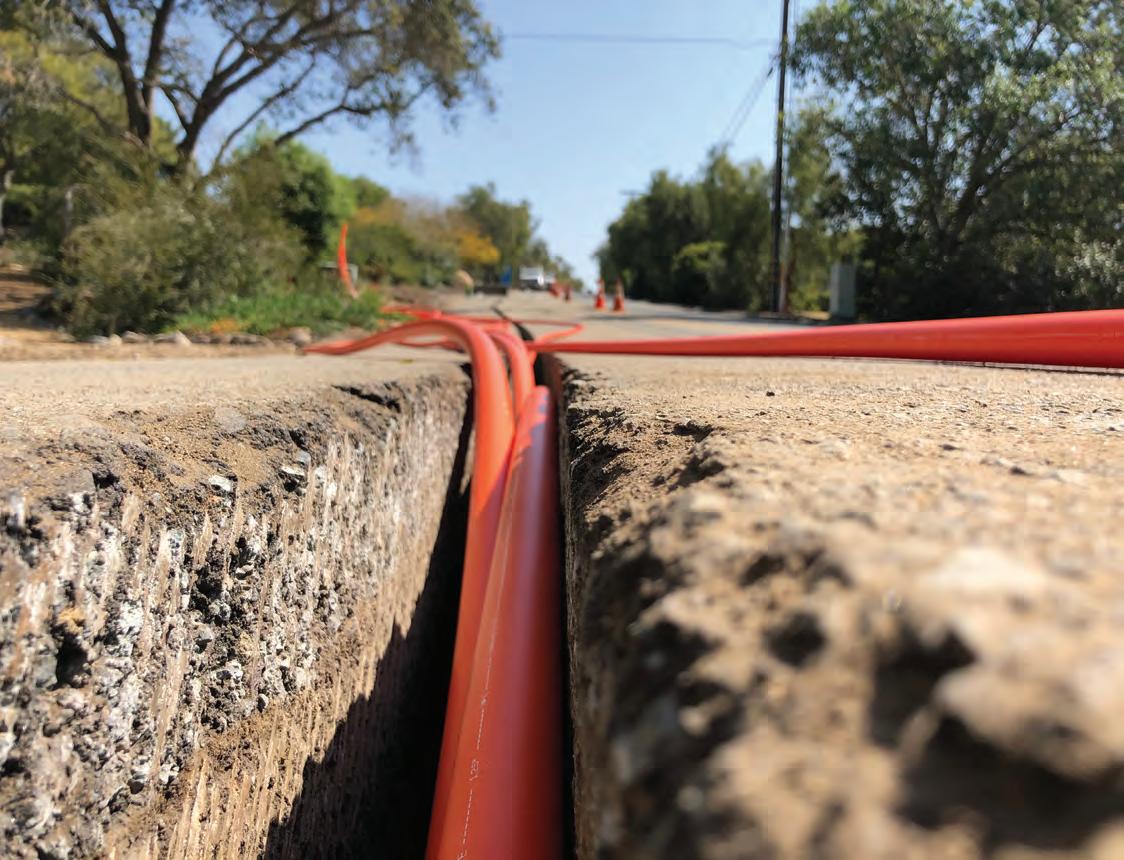
The third area for oversizing is in the termination for fiber. “All this fiber has to be connected to a box somewhere, at a point-of-presence site or a head end or a central office,” said Walton. “The last thing you need to realize is ‘I didn’t put in a big enough box.’ Try to put the biggest shell you can on the wall or cabinet or enclosure to allow for growth down the road. You may put an 864 fiber count leaving the central office but you may not terminate it all because you don’t need it all today. But the housing it will need when it comes time to terminate it will be there and I’d spend the money now to put in the termination blocks and do the rest of the splicing.”
Some service providers are likely to take Corning’s advice with a grain of salt, especially in a more competitive situation. “Tier 1 carriers and the first fiber project down the street generally want to overprovision so they can potentially serve every home and then some,” said Kara Mullaley, Corning Market Development Manager “And then you have overbuild providers who don’t anticipate they will get more than 30 to 50 percent market share, so they aren’t going to put in 100% of the ports and miles to cover everyone.”
In my years in telecom, I’ve never heard ‘I wish I hadn’t put in that big cable.’ It’s usually, ‘I wish I had put in a bigger cable.’
C M Y CM MY CY CMY K ai166094009719_FBA_Guzzler_08-2022_with bleeds.pdf 1 8/19/2022 3:15:00 PM
– Barry Walton, Telecom Solutions Architect, Corning
Latin America: Fiber Connect LATAM –Costa Rica & Training
By Edna Preuss, Director, Industry Affairs & Member Services, Fiber Broadband Association – LATAM Chapter
LATAM in-person is back! After two years of the pandemic, the Fiber Broadband Assocation’s LATAM Chapter was finally able to host a live in-person event. Last year, the LATAM Chapter held two virtual summits with a record audience of over 2,000 attendees for each virtual event, so we knew the demand for in-person was there.
Our Fiber Connect LATAM – Costa Rica event on July 11-12 did not disappoint. The energy was high, and we had a full capacity attendance with a robust line up of amazing speakers. This was the first time the event was taken to the country and brought together more than 400 high-level executives from operators, government and regulatory entities, service providers, and other relevant players from the telecommunications sector and the fiber optics community. It delivered relevant regional topics for discussion by recognized experts in the industry.
Sponsored by more than 20 companies showcasing the newest in fiber optics technology in the exhibits area, the event began with a keynote speech by Costa Rica Vice Minister of Telecommunications, Orlando Vega, who
presented the National Telecommunications Development Plan for the period 2022-2027. “We want to promote the availability of affordable telecommunication services with the quality and innovation at the national level through the timely deployment of secure, robust, scalable, resilient, and sustainable broadband, and develop digital skills by reducing the digital divide in all its components and dimensions, maximizing the benefits of the digital economy for the enjoyment and well-being of everyone,” stated the Vice Minister.
Later, FONATEL (the National Telecommunications Fund) discussed its project to expand connectivity in the country’s public spaces. The keynote speaker on the second day was Luis Adrián Salazar, former Minister of Science, Technology and Telecommunications, who spoke about cloud telecom and the metaverse.
Another highly anticipated presentation was on the FIber Broadband Association – LATAM Chapter’s annual market study. The FTTH LATAM panorama in 2022 is being conducted by SmC+ Consulting, with data related

52 Fiber Forward • Q3
to the progress of fiber penetration in Latin America and its socioeconomic impacts – see important numbers in the graph. The final results will be presented in Colombia in November at the second edition of the Fiber Connect LATAM event.
The conference also explored topics such as the role of fiber optics in reducing the digital divide and promoting the development of the region, regulatory aspects, deployment efficiency, advances in convergence and neutral networks, fiber optics and 5G as pillars of IoT, migration from HFC networks to FTTH, Edge PON, innovation as a tool for the provision of new services, the exponential development of digital ecosystems and their consequences, in addition to the recent law approved for digital nomads in Costa Rica.
Finishing up two days of activities, the LATAM Chapter awarded two network operators for their services in the country. Liberty Costa Rica was recognized as the FTTH Operator winner for its strategic vision around the transformation of its network and execution capacity in
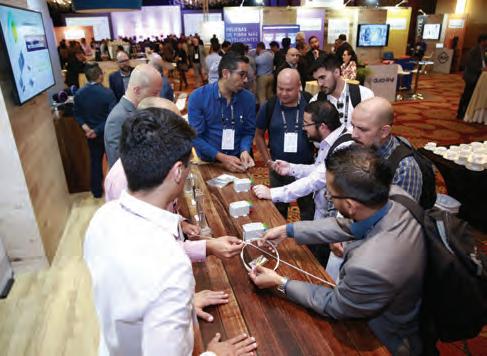
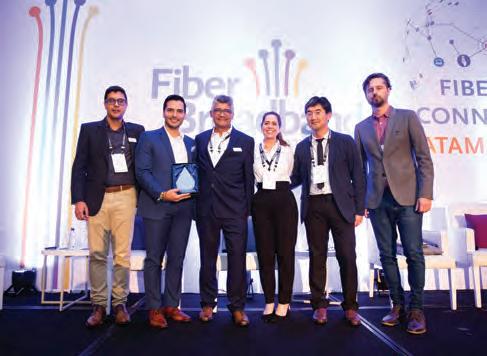

the deployment of FTTH. Mr. José Gutierrez, Sr. Legal & Regulatory Director of Liberty Costa Rica, received the award. I.C.E. was recognized as the largest FTTH operator for the number of users with fiber technology and its collaboration with the development and expansion of fiber optic access. John Molina Nunez, Manager of Technological Transformation received the award for the operator.
After the event, the LATAM Chapter launched its new training program offering a two-day course to professionals from I.C.E., Liberty, Telecable, Tigo, and other operators. The course offered was the FCOE (FBA Certified Field Operations Expert) to teach the best practices in the sector, the methodologies, and standards in the management of optical instruments for the detection of faults in FTTx access optical networks, as well as the evaluation and the main criteria for selecting equipment for its operation and maintenance.
The next meeting will be in Bogotá, on November 8 and 9. To learn more, visit fiberbroadband.org/latamchapter.

53 Fiber Forward • fiberbroadband.org
FBA Chair Kevin Morgan, Eduardo Jedruch, Felipe Antunes, Orlando Vega, Vice Minister of Telecommunications of Costa Rica, Nicanor Ruiz, Liza Poe and Nelson Saito gather on stage at Fiber LATAM. Source: FBA.
Several Fiber Connect LATAM attendees took advantage of on-site training. Source: FBA.
Fiber Connect LATAM Award is presented to Liberty Costa Rica. From left to right: Felipe Antunes, José Gutierrez, Nicanor Ruiz, Liza Poe, Nelson Saito, Eduardo Jedruch, and José Gutierrez. Source: FBA.
The Fiber Connect LATAM expo hall was buzzing throughout the event. Source: FBA.
(cont. from page 22)
to, Leinhart said, with a growing “undercurrent” of people who think they might have one too many services.
“One of the suspicions we have based on the data we see is that some of the growing 20% that thinks we have too many services today is actually due to the complexity of managing across all these different services to find a great video to enjoy,” said Leinhart. “We’ve got growing viewership, we’ve got saturation in terms of the number of services people can handle. Obviously, that means there’s growing competition for people’s viewership eyeballs for the time spent in each of these applications. We see that very prominently in our survey results as well.”
TiVo is able to leverage its live data in order to predict which subscribers might churn/switch services with an 80% confidence rate, providing service providers with a way to engage with customers through more personalization.
“How valuable would it be, if 30 days before they potentially churn, you had an exact list of who on your subscriber base was potentially likely to churn and you had the opportunity to go do something about it,” Leinhart said. “We see a tremendous amount of value in video, not only for consumers, but a tremendous opportunity for video service providers that choose to embrace it and to offer a full-service experience for consumers. It can be a valuable component of the bundle, as it literally can help reduce churn and drive more value and engagement.”
Finding Last Mile Success on the Farm Fresh Road Trip
Closing out the conference, Dr. Christopher Ali discussed what he found when he conducted a “rural broadband road trip” as part of his research for his book “Farm Fresh Broadband, The Politics of Rural Connectivity.”
Ali focused his remarks on how the nation can find success in closing the digital divide. “This brings me to adopting what I’m calling the last mile mindset,” Ali said. “It means putting people at the center of deployment, affordability, accessibility, and inclusion. It means a local approach focusing on customers and customer service. It means that knowing that the digital divide is more than just connectivity, it means affordability, hardware, inclusion, equity. A last mile mindset brings partnerships and cooperation. It means accountability and trust. And that means understanding that we all have a stake in the digital divide.”
At the end of the day, said Ali, broadband is not about policy, politics, technology, or money but a “people first” mindset, as he found in Rock County, Minn. The local government had sought a partner to deploy and operate a fiber network, finally working with Alliance Communications, a telecommunication cooperative next door in South Dakota.
The Rock County network was founded with a combination of funds from the Minnesota broadband office, Alliance, and
a bond issuance by the county. After a single calendar year, Rock County was the most connected area in Minnesota, with a fiber passthrough rate of 99.93%.
Trust was an important part of the equation, with Alliance board members a part of the local community it felt more likely they would make good on their word. “This level of trust Rock County placed in Alliance Communications is the level of trust that all providers should be looking for to garner from their communities,” said Ali. “There is power in the fact that you could run into your provider at the grocery store or at church or in a school meeting. National providers can learn a lot from this to being seen and being trusted.”
Compare that to Surry County, Va., the least connected county in the state in 2020. “Life in a broadband desert is dominated by waiting,” said Ali. “Waiting for a provider, waiting for a webpage to load or waiting for the end of the day so data caps will be released and downloading can begin.” The county recently secured a series of grants for Prince George Electric Cooperative to aggressively deploy fiber to the area in the near future.
“Our job as digital champions needs to be to ensure that unconnected areas like Surry County end up looking a lot more like Rock County,” Ali stated. “The main difference we see is policy support from the state of Minnesota. Minnesota has a state broadband office that is not only focused on offering grants, but advice, coordination, and best practices as well. The experience similarities are also numerous, including the desire for broadband, a concern for schoolchildren, knowing that they are missing out and the importance of partnerships. Hopefully, these two stories set the stage for what is to follow, namely how policymakers, providers, and partners can support a last mile mindset.”
Involvement through electric and telephone co-ops have been “on the vanguard of high quality” affordable broadband development, with almost all telephone co-ops and at least 200 of the 900 electrical co-ops in the nation offering or contemplating retail broadband, Ali said. “One commonality I see is they see broadband as an investment in the community and are willing to take a much longer return on investment than the quarterly returns demanded by large, perhaps investor-owned companies. This longterm community focused outlook makes all the difference when trying to assess the fiscal responsibilities.”
Finally, the citizens in the community need to be involved in the broadband discussion. “It is so important for communities to have a digital champion,” Ali said. “This does not have to be an elected official, an appointed person, or even a civil servant, but someone who keeps the beacons of connectivity lit. Getting broadband to rural, remote, tribal, or low-income communities takes time, hopefully shorter now, but it’s still going to be a few years off. We need to keep the enthusiasm up in the meantime. Find those digital champions in your communities.”
54 Fiber Forward • Q3
(cont. from page 33) services for anchor institutions. “Hospitals and schools are slightly different challenges,” said Gupta. “In Oklahoma, schools get subsidies from OneNet, the state’s research and education network. In the future, we hope to work with OneNet and sell them services which they would then provide to the schools. We have been looking at hospitals a lot. Many of them currently have a primary circuit with a broadband provider that they have had for years. The easiest way to get into that market is to be a secondary provider and then, as that relationship grows, become switched to a primary provider.”
Gupta fully believes that electric co-ops are the future for rural internet deployment as rural operators are the entities that best serve rural populations in America. “We are very engaged with the community here. In a short amount of time, I have personally visited 14 different cities and talked to mayors and city managers in all of them. Every time I meet with these communities there is always angst. They say, ‘We never get services from the large providers because they don’t see financial motive to come here.’ There is this worry that if larger providers get deployment money, that they will come provide service for a short amount of time, then decide to leave as it is not profitable for them. What will happen then? We have been here for eight decades. We are going to be here for the next eight decades, so there is never a question of us ever leaving our communities behind. We are not outsiders to the community we serve; we are part of that community.
West Wisconsin Telecom Cooperative Beef and Beans
Quick Facts
• Telephone cooperative
• Headquarters location: Menomonie, Wisconsin
• First residential fiber: 2005
• Homes passed as of interview: 4,000
• Customers as of interview: 3,362
• Who we spoke to: Lori Myers, Office Manager, West Wisconsin Telecom Cooperative
• Unique points: Steady growth through 23 state broadband grants, enabling farmers
West Wisconsin Telecom Cooperative became involved with fiber more than a decade ago and has steadily been building out its fiber network for both residential and commercial customers.

“The cooperative was established back in 1954,” Myers said. “A group of farmers got together because they wanted to get rid of the party lines. The coop service area expanded into six different counties serving twenty-nine townships, with other technologies coming into play. We started offering dial up internet and we could see it was going to grow and stay. The Board of Directors and our
CEO thought that we should beef up our network since the copper plant wasn’t going to take care of our customers’ needs. By 2008 we finished the process of covering our cooperative with 100% fiber-to-the-home and launched digital TV with great success. We were getting calls from neighbors that wanted us to expand our network, little communities and townships that wanted fiber to an industrial park and the home.”
The co-op started pursuing grants from the state to provide service to neighboring towns, landing its first one in 2016. Today, West Wisconsin has been officially awarded a total of 23 broadband awards from the state –11 just this year – and expect they will be awarded another three in the fall of 2022. “In total we serve 23 townships or parts of them,” Myers said. “We’re building fiber to areas that were once served by large providers and lack quality broadband.”
Expansion has had its ups and downs. “We bury all of our fiber,” Myers stated. “Most of the townships are good to waive the permit fees. Boring under the river and hitting shale has been a special challenge. Right now, we’re paying really close attention to all the supplies and equipment we need. Who would have thought we would have a shortage of pedestals to build our network?”
Bringing fiber into the local communities has enabled farmers in the region to sell their products to markets around the globe. “We have a farmer who is selling his beef cattle worldwide,” Myers said. “We have another large enterprise, Chippewa Valley Bean. They’re the largest producer of kidney beans in the nation. They have talked about how they would not be that type of company if they did not have fiber.”
55 Fiber Forward • fiberbroadband.org
24-7 Dunn County Fairgrounds FTTH. Source: West Wisconsin Telecom.
WEST COAST
South Valley Internet/Garlic.com
From WISP to Fiber
Quick Facts
• Privately-owned phone company
• Headquarters: San Martin, California
• First residential fiber: 2019
• Homes passed as of interview: 150
• Customers as of interview: 3,000
• Who we spoke to: Elise Brentall, President & Chief Operating Officer, South Valley Internet
• Unique points: Wireless to fiber, Garlic capital of the world
Located below Silicon Valley, South Valley Internet (SVI) is a small privately-owned phone company that was started by two ham radio buddies as a dial-up provider in 1994. Today, it is delivering broadband and voice services to the communities of Hollister, Morgan Hill, and Gilroy – best known as the Garlic Capital of the world and where the firm gets its Garlic.com identity.
“We are in a semi-rural environment, we’re maybe 25 miles south of the heart of Silicon Valley, so the area is big into agriculture and a bedroom community to the Valley,” said Brentall. “The majority of people who live here are engineers, executives, or some sort of marketing and sales support for large corporations to the north.”
When one of the two co-founders retired in 2006, CEO and remaining co-founder Robert Brentall – Elise’s father -- grew the Internet Service Provider (ISP) into a more complete communications company delivering voice and data services, gaining experience with copper, wireless, and fiber.
“When we became a CLEC in 2016, I became very interested in learning more about fiber,” said Brentall. “Seeing how crappy – sorry – the copper we were leasing was and it hadn’t been taken of, it was just wreaking havoc on us. We applied for RDOF funding and were told California wasn’t the broadband story they wanted to tell in Washington D.C. We ended up getting a partial grant from the California Advanced Services Fund and put in wireless services to Paradise Valley, an area we know was going to be very expensive to service, but the people desperately needed it.”
Wireless broadband service sounded like an affordable alternative at first glance, but the area had too many blind spots between trees and hills. “It has steep canyons and is heavily wooded. With all the obstacles, we could only get 30 to 35% of the people we wanted to serve.”
Fiber proved to be a hit to the residents of Paradise Valley.
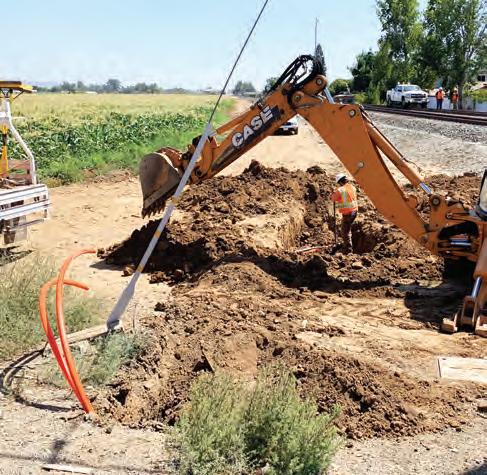
“We projected a 62% take rate and we ended up with a 90% take rate with 150 homes,” Brentall said. “We don’t get called out for service interruptions like we did with wireless, which is much more susceptible to atmospheric and environmental effects. Fiber just works. We have virtually
no tech support on it. When you’re looking at $150 just for a truck roll plus the cost of people, that adds up fast. With fiber we don’t have it.”
Brentall described the actual network build process as “really pleasant” since SVI hired a local contractor that knew the area. “The county of Santa Clara was very gracious and very nice to work with,” she said. “The biggest pain was working with the water district because we were going under a creek. They were doing flood control work and we had to go extremely deep there, which meant it was a very long and expensive bore. But once we got the ball rolling and got them engaged, they were pretty good to work with as well. We were very lucky in that regard.”
Moving forward, SVI is looking at deploying more fiber by tapping into California and federal funding, a necessity given the expensive nature of construction in the state. “Everything in Santa Clara County is expensive. Engineering is expensive. Boring is expensive. If you want to go on the poles in the state, it’s extraordinarily expensive. You have to become a part of the Pole Association and if the poles haven’t been tested in the last five years, you must pay for that. If you have to further work to get on the pole, you must pay, which makes going on the poles not very cost effective.”
Underground is how SVI will go, but that’s not easy, either. “The state of California wants everything underground, so I’d just rather do it now and not have to pay the expense down the road. We have to bore. The County of Santa Clara doesn’t allow trenching or microtrenching or anything of that sort. It’s boring or nothing at all.”
56 Fiber Forward • Q3
South Valley Internet bores under a RR track as it extends its FTTH network. Source: South Valley Internet.
Matanuska Telecom Association (MTA) North to Southwest Alaska
Quick Facts
• Telephone cooperative
• Headquarters: Palmer, Alaska
• First residential fiber: 2007
• Homes passed as of interview: 6,000 structures
• Customers as of interview: 34,000 members, 60,000 structures
• Who we spoke to: Michael Burke, CEO, MTA
• Unique points: Alaska, Operates last mile, middle-mile, and long-haul fiber networks

Alaska, the “Last Frontier” state, poses significant challenges in running a telecommunications company, including distance, weather, and wildlife, with bears making life interesting for construction crews and fiber techs.
“Matanuska Telecom Association serves a footprint that’s approximately 10,000 square miles, so it’s roughly the size of the state of Maryland,” said Burke. “It is a place where people are spread out, where people like to live and have land around them. There’s not a lot of what I’d call geographically dense areas. Building infrastructure involves the planning of a lot of miles of plant in order to be able to connect all our customers together.”
MTA serves around 34,000 coop members and around 60,000 structures in its territory. “Our intent is to take all 60,000 of those locations and connect them with fiber and continue to build out the growth that’s also going on in our area,” said Burke. “You’re talking roughly 5,200 miles of copper plant that is out there that we’re in the process of going in and overbuilding into fiber. In addition, we’ll have anywhere from 1,000 to 1,500 new structures that appear every year, greenfield builds. It will be a fairly big project and challenging from the standpoint that in Alaska, we only have about a fivemonth construction season that runs from the middle of May to the middle of October. You’re trying to race and do as much as you can in five months every year to try to achieve all of that.”
MTA stated that its biggest non-weather challenges are the same as many service providers, supply chain and manpower issues. “Right now, the average order time for new fiber is about 70 weeks for us,” Burke stated. “We’re ordering fiber this summer for projects we are anticipating doing in 2024 and having to stockpile materials because of the uncertainty of when we can get some of those items in the future.”
Getting a sufficient workforce is also something MTA has to monitor carefully. “Some of our contractors during our summer construction are working seven days a week, 10 hours a day,” Burke said. “They’re doing it because there is a lot of work to be done and they are not able
to find enough people to work a different schedule. Going forward, it’s going to continue to be a challenge from a management standpoint to make sure we have the materials and workforce needed to keep up with the buildout we are trying to do.”
Unique to the telephone co-op world, MTA has built the AlCan ONE all-terrestrial fiber network connecting Alaska to the lower 48 states. It is the only all-terrestrial fiber network between Alaska and the rest of the states, with other connectivity provided by submarine cables vulnerable to disruption by underwater earthquakes and volcanoes along the region’s Ring of Fire fault lines.
“We’re the only carrier in Alaska that has that kind of connectivity in and out of the state and it obviously provides great resiliency and geographic diversity from the traditional submarine cables that have connected Alaska to the lower 48 states,” Burke said. “It runs from Alaska down into British Columbia, then Alberta where it connects with other fiber networks where we can go to Seattle, Chicago, and the East Coast.”
Ironically, MTA had to wait in some areas until the freeze over in winter to put in AlCan ONE long-haul fiber. “We couldn’t do work in the summertime along the Alaska-Canada Highway because it’s boggy. We had to wait until winter when the ground froze at 20 below, so you could take heavy equipment into the marshland and plow in conduit.”
57 Fiber Forward • fiberbroadband.org
Line crews work in a remote neighborhood in Wasilla Alaska to upgrade existing equipment. Source: MTA.
November
2022
Materials due October 19, 2022
• Fiber Under Forty - Identifying young, emerging leaders in the industry

• Progress report – Where are we with $65 billion?
• Broadband for Good including: Decreasing the digital divide; Telehealth/ Telemedicine; Public Safety
• Executive Insights | Federal/State Update | Community Profiles | Innovation at Work
• Special distribution at Premier Members Meeting in December 2022
March 2023
Materials due February 16, 2023
• State Broadband Office Programs and People
• Inside look at FBA’s 2023 Chair and Board of Directors
• Premier Member Meeting Highlights
• Executive Insights | Federal/State Update | Community Profiles | Innovation at Work

FBA 2022-2023 Event Calendar
November
2022
Columbus, OH
2023 Schedule and Locations Coming Soon!
November
58 Fiber Forward • Q3
2022-2023 Editorial Calendar
Workshops
Regional Fiber Connect
3,
Fiber Connect LATAM Events
8–9, 2022
Colombia Email latamchapter@fiberbroadband.org
more information. FBA Annual Premier Members Meeting December 5–6, 2022 The Don CeSar Clearwater, FL Fiber Connect 2023 Conference & Expo August 20-23, 2023 Gaylord Palms Resort and Convention Center Kissimmee, FL Grab your spot now in the upcoming Fiber Forward issues! Contact Lucy Green at lgreen@fiberbroadband.org for sponsorship opportunities. Please note editorial topics may be subject to change based on future events and market shifts. 2022 EDITION 2 Ensuring Fiber Reaches Everywhere A view from the states. Fiber Connect 2022 Panel Preview. Page 38 Women Changing Fiber for Good Insights from the past, improvements for the present, investing in our future. Page 25 Welcome to the Fiber Future! Celebrating a historic moment for our industry and country. The industry gathers at Fiber Connect 2022 to celebrate monumental progress – Join us in Nashville! FIBER-CONNECT-2022-Q2-PAGE-1-V8.indd 1 5/18/22 AM
Bogota,
for

Enabling the Lifestyle that Better Broadband Provides
Challenging the Status Quo with FastPass

DOUBLING Your Rate of Homes Passed is a Matter of TIME
Surpassing your deployment milestones by doubling the rate of your PON cabinet deployments is possible with Clearfield’s FastPass™ approach. Our customers do it every day with in-cassette splicing.
FastPass takes you to the front of the line in your race to revenue.
Splicing inside the Clearview® Cassette will:
• Double your cabinet deployments

• Minimize your labor costs
• Reduce operational/maintenance costs
Accelerating deployments means accelerated subscriber revenues and improved service turn-up time. Ask Clearfield to show you how.
Removing Barriers to Fiber Deployment
Learn how to simplify your deployments at www.SeeClearfield.com or call 800-422-2537
10 Fiber Forward •
Q3




























































 By Doug Mohney
By Doug Mohney




































































 By Doug Mohney
By Doug Mohney




 By Doug Mohney
By Doug Mohney



















